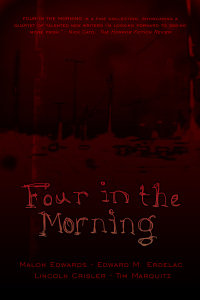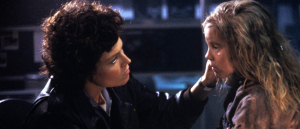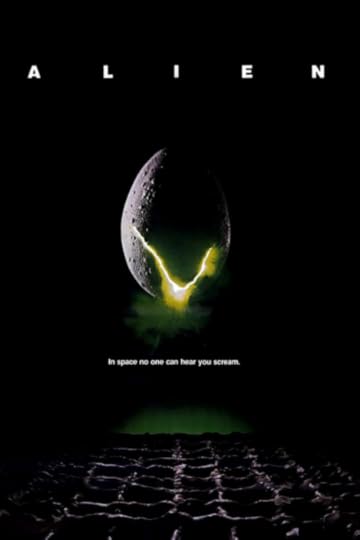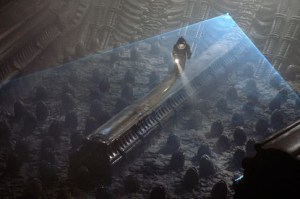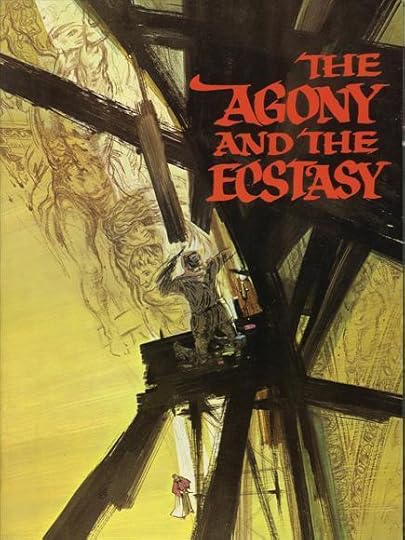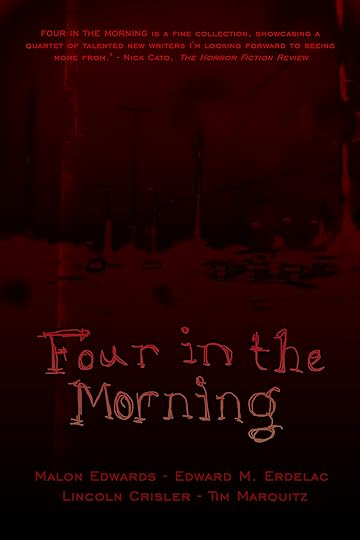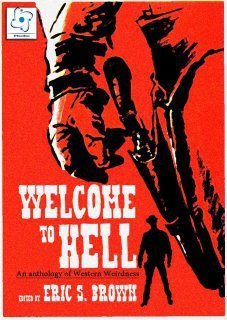Edward M. Erdelac's Blog, page 35
June 25, 2012
DT Moviehouse Reviews: The Apostle
Time once more for my blog feature, DT Moviehouse Reviews, in which I make my way alphabetically through my 200+ DVD/Blu-Ray collection (you can see the list right here) and decide if each one was worth the money. Here’s my take (and slight rant) on Robert Duvall’s heinously underappreciated The Apostle.

(1997) Directed by Robert Duvall
Written by Robert Duvall
Tagline: The Hardest Soul To Save Was His Own.
What it’s about:
Boisterous Texas Pentacostal minister ‘Sonny’ Dewey (Robert Duvall) learns his wife (Farrah Fawcett) is having an affair with youth minister Horace (Todd Allen). When his wife utilizes the nonprofit bylaws to wrest control of his church away from him, in a fit of drunken rage Sonny confronts the two of them at his kids’ Little League game and strikes Horace with a bat, putting him into a coma (from which he later dies). Sonny drives his car into the river, tosses away his ID, and goes on the lam. Praying for understanding and direction, he flees to Louisiana where he baptizes himself in the Mississippi River as ‘The Apostle E.F.’ and sets out with a local reverend named Blackwell (the wonderful John Beasley) to resurrect a one room country church.
Why I bought it:
The best acting performance of 1997 definitely wasn’t Jack Nicholson as himself in ‘As Good As It Gets.’ It was Robert Duvall as The Apostle E.F. in this movie.
We’re talking about one of the greatest screen actors of the past five decades, at the top of his game, in a passionate, transformative performance. Duvall is a consistently great actor. At a time when DeNiro and Nicholson and Pacino had all fallen back on their laurels to play themselves (or the public’s conception of them) time and time again, Duvall came out with The Apostle and it was AMAZING.

Best Actor….for As Good As It Gets?? Hocus Pocus…
I watched this Academy Awards presentation, and I watched him lose to Nicholson, and I thought W-T-F? I also saw (and this is just me projecting my own emotions – I have no idea what Duvall was really thinking) in Robert Duvall’s eyes the entire rest of the night, just this intense wound. Now, he was gracious as all get out, and smiled and didn’t pitch a fit. I remember when they traipsed out all the past Best Actor winners for a big onstage photo op he was there (for Tender Mercies back in the 80’s – when he first conceived of and unsuccessfully pitched ‘The Apostle’ to producers), smiling, but I felt like it was a hollow smile, like he’d really given his all and just got the cold shoulder for it. Man, I just really felt for the guy that night. I think it might’ve been the last AA show I went out of my way to watch. I can’t really say I was jaded at the time, but I just felt so intensely disappointed for the man, that the fun of watching the Oscars was kinda wiped out for me. Nicholson??? For As Good As It Gets???And now, rewatching The Apostle, I revisited that same emotional reaction, because Duvall’s performance is just as good as it was in ’97. And I got to thinking, why did The Apostle get the John Carter treatment? It made only $40,000 dollars opening weekend. Forty THOUSAND dollars!
Of course, as it caught on with church groups, it wound up making twenty million, four times its estimated budget (according to imdb), but still.
I remember the night I went to see this movie. I was excited as all get out for it because one of my film school teachers had showed us one of the opening scenes and it just blew me away.
In the scene, Sonny and his mother (June Carter Cash) are driving along and come across a car wreck out on a country road. The police are all over the place, but the ambulance hasn’t arrived yet. One car is on the road and a couple are sitting on the bumper, having sustained minor injuries, but the second car has apparently ploughed into a field and is just twisted all up.
Sonny pulls the car over, grabs his bible, and high tails it out to the wreck. He pokes his head inside and sees a young couple. The boy is pushed up against the steering wheel, blood trickling from his scalp and nose, very stiff, but wide-eyed, as though he might be paralyzed. In the passenger seat is a young girl, his wife or girlfriend, and she’s unconscious, bleeding.
Sonny reaches in and takes the girl’s hand and puts it on the boy’s arm. He proceeds to ask the boy if he’s ready for his soul to depart, and asks him to accept Jesus Christ as his personal savior. The boy begins to cry, and answers in the affirmative.
At this point one of the state troopers comes up and tries to get Sonny to move on. Sonny waves the cop off, even kicks him back at one point, until he finishes his benediction over this couple. The boy manages a weak ‘thank you.’
When Sonny finally disengages, the cop says;
“I ‘spose you think you really done somethin’ here.”
“I know I did,” answers Sonny. “Let me tell you something. I’d rather die today and go to heaven, then live to be a hundred and go to hell.”
He then goes back to his mother and as they pull away, they pray and sing for the couple’s recovery. Under the soulful impromptu a capello strains of June Carter Cash as she sings ‘The Far Banks of Jordan,’ we cut back to the wreck, and see the girl’s fingers tighten on the boy’s arm.
I found this to be a deeply spiritual scene, very moving. I hadn’t seen a preacher positively portrayed in a film in years, and here was an obviously selfless act. Sonny doesn’t slip a business card into the kid’s shirt pocket or tell the cops to call his church or something. He plies his real trade, which is the business of saving souls, and moves on.
Well, I went to see The Apostle late one night after work along with three other people. An elderly African American man, a middle aged white woman, and an old white lady.
That is, that was who I saw the movie with. That was the entirety of the audience. And twenty two year old me (we all enjoyed it immensely).
And when I was directed to the theater by the usher, they had already changed the marquee (I think to Titanic, which I still haven’t seen), so I had to ask if it was the right picture.
Needless to say, I was astounded by the movie that enfolded. It was almost like watching an ethnographic documentary.
Duvall’s direction is, like the best kind, non-invasive. There’s not a bunch of Hollywood smash cuts and tricks to remind you you’re watching a movie (which so many film directors resort to these days). The sermons and the preaching are long takes and long to medium shots, and the cast is a mix of fantastic professional character actors (James Gammon, John Beasely, country singer Billy Joe Shaver) with real southerners, ministers, thunderous, uplifting gospel choirs, and quirky everyday folks (the two bickering African American ladies in Sonny’s fledgling congregation are standouts, as are Jack Dial, an Arkansas furniture store owner who plays the local radio DJ that lets Sonny evangelize on his station). This enhances the emotional impact of the drama to the nth degree.
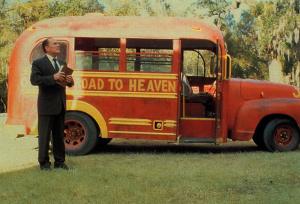 And what’s even more daring is the subject matter. Sonny is not wholly good, but he’s not wholly bad either. He’s definitely the real deal when it comes to preaching. This is shown early on in the aforementioned car wreck scene, and in flashbacks to his childhood, where he is first exposed to the Southern African American style of preaching as a boy with his (I presume) nanny. We later see him at about the age of ten or eleven up in front of an all black congregation himself roaring in his squeaky voice at adults about sanctification.
And what’s even more daring is the subject matter. Sonny is not wholly good, but he’s not wholly bad either. He’s definitely the real deal when it comes to preaching. This is shown early on in the aforementioned car wreck scene, and in flashbacks to his childhood, where he is first exposed to the Southern African American style of preaching as a boy with his (I presume) nanny. We later see him at about the age of ten or eleven up in front of an all black congregation himself roaring in his squeaky voice at adults about sanctification.
But he admits to his wife when confronted with the end of their marriage that he has always had a wandering eye, and he is definitely prideful, strutting in an ice cream suit and sunglasses before the big congregation his wife has taken away from him (there’s a great bit of dialogue after that scene where one of his supporters says, “They sure ain’t gonna forget you droppin’ that fifty dollar bill in the collection box.” To which Sonny replies, “It was a hundred dollar bill.”) and flat out refusing to consider taking the reins of another (“This is MY church”).
And of course his dark side comes right to the fore when he visits his son’s Little League game drunk and proceeds to bust his wife’s paramour across the face with his boy’s own bat (“That’s one for the road, Rodney. One for the road.”), then tries to drag her ‘home’ by her hair.
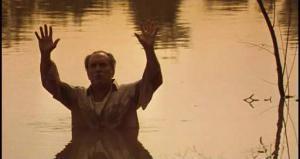 Hollywood and fiction in general has treated us to negative portrayals of churchgoers and corrupt preachers since Elmer Gantry, but where The Apostle veers off and is refreshingly original, is that Sonny, despite all he’s done, is still basically a good man. His personal life is a complete shambles due to his own weaknesses, but he is still no con artist. He does believe in God, and he genuinely does care about peoples’ souls. After he learns of Horace’s condition, he prays for his recovery.
Hollywood and fiction in general has treated us to negative portrayals of churchgoers and corrupt preachers since Elmer Gantry, but where The Apostle veers off and is refreshingly original, is that Sonny, despite all he’s done, is still basically a good man. His personal life is a complete shambles due to his own weaknesses, but he is still no con artist. He does believe in God, and he genuinely does care about peoples’ souls. After he learns of Horace’s condition, he prays for his recovery.
The night before his attack on Horace, he paces his bedroom shouting to the ceiling of his mother’s house at the top of his lungs in a one sided, deeply personal conversation with God which on its surface is humorous, but really makes his devotion and faith shine. God is not some concept to him, some ideal he pays lip service to get people through the doors of his church. He has a personal relationship with the Lord, and by personal I mean it is less of a reverential deference one might imagine giving say, the President, as it is a rapport with a good friend (“I always called you Jesus, you always called me Sonny. I love you, Lord. But I’m mad you. I am MAD AT YOU!”). Sonny’s faith is very real.
Does this make him a hypocrite? To some degree, yes of course. But strive as they might, all people are hypocrites about something. They are human, and they make mistakes.
Which I think, brings me to the reason The Apostle got the shaft.
It’s because it doesn’t feed into the popular conception of Christian ministers as being political-minded, holier than thou, money grubbing homophobes bent on changing the way ‘the rest of us’ (whatever that means) live our lives.
And that is indeed a very popular conception. I see it in the deliberately antagonistic (they assure people its just irreverent), baiting posts of some of my fellow professionals and friends on Facebook every day. I see it in movies and TV and fiction I read. Where does this desperate need to take from people something that gives them joy and peace come from? I think much of it stems from personal issues. I know for instance, I intensely dislike team sports because of my own experiences in middle school, but I recognize that many people enjoy them a lot and take great pleasure and comaradery from them. It’s my own hangup, not a failing of sports fans.
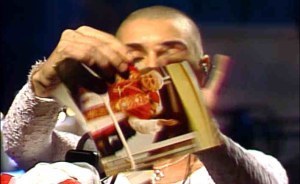 I recently re-watched an old episode of Saturday Night Live, which Joe Pesci hosted. It was the week after the infamous show where the Irish pop singer Sinead O’Connor tore a picture of Pope John Paul II in half in protest against the Catholic Church’s views on abortion and birth control. Pesci opened his monologue by taping what he said was the same photograph back together and saying, in his best wiseguy mode, that had he been there, he ‘would’ve given her such a smack.’
I recently re-watched an old episode of Saturday Night Live, which Joe Pesci hosted. It was the week after the infamous show where the Irish pop singer Sinead O’Connor tore a picture of Pope John Paul II in half in protest against the Catholic Church’s views on abortion and birth control. Pesci opened his monologue by taping what he said was the same photograph back together and saying, in his best wiseguy mode, that had he been there, he ‘would’ve given her such a smack.’
I was pretty chagrined, but the audience (and this was a New York City audience!) erupted into cheers and applause.
I couldn’t help thinking how the national consciousness and our attitudes towards religion have changed in the intervening years.
Of course Pesci’s comments were reprehensible, but they were apparently encouraged by the approving audience. But this was the late 80’s, before the Catholic abuse scandal broke, and I really trace the changing of the national tide to that ultimate betrayal of trust.
What most concerns me nowadays (and here’s where the brief rant begins) , is that those that consider themselves educated, tolerant, and liberal-minded suddenly become rabid hypocrites when the subject of belief in God comes up. Seriously. I mean Westboro Baptist style antagonistic. It’s not OK to really and truly express belief in God anymore. Among the artistic community especially, it’s folksy and stupid, and should be a practice confined to dumb yokels, not intelligent, urbane people.
And I really think this is why The Apostle initially failed (and why Duvall was criminally ignored). It’s not popular to think of devout Christians as being capable of good. They’re all backwards hate mongerers and racist Republicans, right? Well, no. No they’re not. No more than every atheist is a communist monster without a moral compass. The definition of true tolerance towards our fellow human beings is not ‘I love and respect everybody so long as they believe what I believe.’ Yes, some deists are unfortunately guilty of this, but so are an increasing number of atheists.
If The Apostle were called The Shaman, and was an amazingly accurate, positive, and compelling portrayal of say, a Papua holy man in a remote village in the back country of New Guinea preaching his animist beliefs, wouldn’t most people see it as a fascinating time capsule, a worthy portrait of a unique and alien (to most of us) way of life? And wouldn’t whichever actor lost himself in such a role be deserving of the highest praise, if he successfully made the audience empathize with a character so entirely outside their own experience?
Well, that’s exactly what The Apostle is, and that’s exactly what Robert Duvall did. And if you haven’t seen it because holy rollers are nuts and belief in God is as stupid and irrational as belief in Santa Claus (but I’ll bet you’ve seen Bad Santa or The Santa Clause or one of the Rankin and Bass specials), then you missed out. And you’re not as tolerant as you think you are.
The philosophy of The Apostle is flat-out stated in a scene where Sonny observes a congregation of Cajun bayou boats being blessed by a Catholic priest.
“You do it your way, I do it mine, but we get it done, don’t we?”
That I can get behind.
OK, end rant.
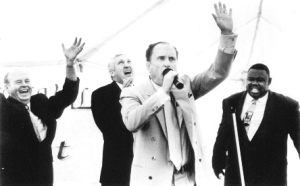 The Apostle, besides being the journey of Sonny from sin to redemption, is an enthralling showcase of a vibrant and interesting American subculture, as diverse and beautiful as any. Prior to Sonny’s fall there is a sequence in which we see him in attendance at several different ministry events, from tent revivals to Holiness worship, to a mesmerizing Promisekeepers type event where hundreds of well dressed black men pump their fists in unison and respond JE-SUS again and again in one voice to the ministers’ prompts. The preachers in these scenes are actual Pentacostal clergymen, and they vary wildly in their styles and vie with each other in terms of exuberance, and Duvall steps in and amazingly holds his own.
The Apostle, besides being the journey of Sonny from sin to redemption, is an enthralling showcase of a vibrant and interesting American subculture, as diverse and beautiful as any. Prior to Sonny’s fall there is a sequence in which we see him in attendance at several different ministry events, from tent revivals to Holiness worship, to a mesmerizing Promisekeepers type event where hundreds of well dressed black men pump their fists in unison and respond JE-SUS again and again in one voice to the ministers’ prompts. The preachers in these scenes are actual Pentacostal clergymen, and they vary wildly in their styles and vie with each other in terms of exuberance, and Duvall steps in and amazingly holds his own.
Sonny’s sermon scenes are really a treat to behold, intense, sometimes funny, often heartfelt, always entirely believable. He’s like a man with Tourette’s who spits out glory and praise instead of profanity. The man lives always with God in mind.
Duvall went far out on a limb, financing this movie personally when producers told him they’d rather see the same old corruption of a two faced minister portrayed than the redemption of a realistically flawed human being. It’s a true labor of love in every sense of the word.
And though Duvall’s shadow is hard to get out from under, the rest of the cast, even the non-actors, hold their own, down to the Cajun kid who plays the accordion in church, and the old man with the trumpet. The lovely Miranda Richardson is pleasant as a would be (but ultimately doomed to fail) love interest.
Sonny is a believable human being, warts and all, something you don’t see very much in the movies. It’s refreshing to see such a demonized subculture get a fair and positive treatment.
Best bit of dialogue:
This is very hard to pick. Much of the sermonizing is extemporaneous. Duvall said he took a lot of notes listening to other preachers, and particularly in the penultimate sermon before the Louisiana State Police come to haul Sonny off to jail, the behind the scenes extras state that there was a three camera set up that just sat back and ran for hours as Duvall preached. He said he knew the points he wanted to make at each part in the story, but he allowed himself to work his way to them naturally.
As a result, picking good lines in The Apostle is like picking the gems from Popeye’s speech. And I mean that in the best way. Jack Mercer, the voice of the famous cartoon sailor, was an extremely talented, hilarious man, who peppered Popeye’s dialogue with wonderful blink and you’ll miss it extemporaneous asides, and The Apostle is like that, very naturalistic, so lulling and organic that you’ll miss the gold. As I watched it, I actually jotted a few down that I haven’t already mentiond.
 “The eleventh commandment thou shalt not shout….doth not exist.”
“The eleventh commandment thou shalt not shout….doth not exist.”
“Now I know this church ain’t much….”
“Ain’t much? Why I’d fight ten men for it!”
“Do you wanna be on the Devil’s hit list? Then you better get on Jesus’ mailing list.”
“[on hard work] I quit school ‘cause I didn’t like recess.”
“[with his arrest pending, as he kneels in front of the little church with a tearful young mechanic played with understated believability by The Shield’s Walton Scoggins] St. Paul says any man who accepts Christ as his savior is a saint. You’re a saint, Sammy. You’re goin’ to heaven. I’m goin’ to jail, you’re goin’ to heaven.”
Best scene:
Well as I said, the car wreck scene is what drew me into this movie, but midway through there is a beautiful sequence involving Sonny and a character credited as The Troublemaker (Billy Bob Thornton). Thornton arrives one night at Sonny’s little multiracial One Way Road To Heaven church looking to start something, and when Sonny invites him outside, he states he ‘wouldn’t want to sit around with a buncha niggers,’ which induces Sonny to beat the crap out of him and tell him not to come back.
Later, the church has a picnic out front and Thornton returns with a couple of his yokel buddies and a bulldozer (with a revolver prominently holstered in the cab). He declares he’s going to knock down the church.
Sonny responds by opening his bible and laying it on the grass in front of the vehicle.
“If you wanna knock down my church you’re gonna have to roll over that holy book and brother, if you do that, I wouldn’t wanna be sittin’ where you’re sittin.’”
Thornton orders one of his cronies to pick up the book and the guy shakes his head and leaves.
He gets down himself and declares his intent to do it.
Sonny replies, speaking to his gathered congregants;
“Nobody can move that book.”
They repeat it four times, and Thornton shakes his head and says;
“I can move it as quick as you can.”
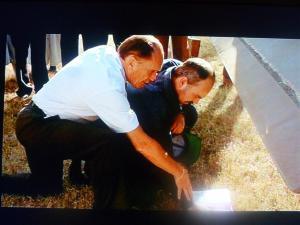 And he kneels down to do it. Sonny slips down beside him and puts a gentle arm on his shoulder.
And he kneels down to do it. Sonny slips down beside him and puts a gentle arm on his shoulder.
“No sir. Nobody. Nobody moves it. Nobody. I know why you came here. You didn’t come here to knock my church down, did you? You came for another reason, didn’t you?”
“No, I came to knock your church down.”
“No sir.”
“Yes sir, I did.”
“Well you ain’t gonna knock it down. I want you to know that.”
Thornton pauses and glances over his shoulder.
“I didn’t come to knock your church down.”
“Yes sir. I know. I know. That’s why I’m kneeling with you. I’ll pray with you if you want me to. I’ll even cry. I’ll do anything you want me to do with you…’cause I know you’re a good man. I know it. Now if you reach out, the Lord will accept you here today. If you reach out, He’ll accept you here forever more. He will love you forever, even as we in this church love you now. Forever more. Do I hear somebody say “Amen”?
The parishoners shout “Amen!”
Thornton is crying by this point, and he whispers,
“I feel embarrassed.”
“You don’t have to feel embarrassed. I was a worse sinner than you were in my time. I was a worse sinner than you were. Go ahead, brother, cry. I’ll cry with you. I’ll cry with you. Somebody say, “the Holy Ghost is here right now.”"
“The Holy Ghost is here right now!”
The crowd chants this again and again, until one of the women starts singing ‘Victory Is Mine,’ and Sonny and Thornton rise to their feet together.
It’s just a wonderfully moving scene of brotherhood and acceptance.
Would I buy it again? Yes.
NEXT IN THE QUEUE: At The Circus








June 14, 2012
Great White Horror In Tales From The Bell Club
No, not sharks.
In all the Four In The Morning and Prometheus excitement, I missed telling you all about the release of Knightwatch Press’ very cool horror pulp anthology Tales From The Bell Club, featuring my short story Tell Tom Tildrum and edited by Paul Mannering. It also features The Wager, a yarn of un-fathomable submersible horror from my good friend and sometime collaborator Jeff Carter.
You can read about Jeff’s story at his blog here.
Take a look at this great cover…
The premise of Tales From The Bell Club is that there exists a upscale private club, much like the world famous Travellers Club, Mycroft Holmes’ Diogenes Club, or the Cobalt Club (to which Lamont Cranston belongs in The Shadow series). The Bell Club’s sole requirement is that prospective members must have undergone some personal horror and agree to share the tale.
All stories are set in an era ranging from the early 1900′s to the mid to late 1930′s – the ‘golden’ age of adventure and pulp.
My own offering is called Tell Tom Tildrum, a reference to the old English fable, The King ‘O The Cats (special thanks to Jeff for pointing out this tale to me and giving me a springboard).
For sake of context, in The King ‘O The Cats, a gravedigger witnesses a body of feline pallbearers carrying a small casket in which lies a dead cat in state, with a golden crown upon its head. One of the cat onlookers notices the gravedigger and tells him to tell Tom Tildrum that Tim Toldrum is dead. The terrified and bewildered gravedigger returns home to his wife and relates the strange tale, but despairs that he has no idea who Tom Tildrum is. At that point, their housecat, who had previously been sitting on the floor supping milk from a pan, rises up on two legs and declares;
“If Tim Toldrum’s dead, then I am the King ‘o Cats!”
And leaps through the open window to go scampering down the lane toward the graveyard.
My story concerns the application for membership in the Bell Club of one Captain Howe, an arrogant, racist and cruel veteran of the King’s African Rifles, the British colonial suppression of Africa, and the Great War who settled in the Wainhoji River Valley in Kenya and made a living as a safari guide and big game hunter for the notorious Happy Valley Set.
The Happy Valley Set was a scandalous collection of aristocratic young British ex-patriots and American socialites living in the shadow of the Aberdare Mountains whose promiscuous sexual and narcotic exploits were nefarious throughout the 20′s.
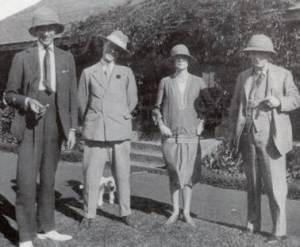
The Happy Valley set: L to R: Raymond de Trafford, Frederic de Janze, Alice de Janze (with two of her husbands) and Lord Delamere.
The colony was founded by Hugh Cholmondeley, the 3rd Baron Delamere, who became one of the region’s first white land owners and was instrumental in drumming up homesteaders from among the wealthy British peerage. Interestingly, he also was the first to coin the term ‘white hunter’ (he employed both a Somali hunter and a white man named Black, and so began referring to them as ‘white hunter’ and ‘black hunter’ respectively). An eccentric but dogged character in his own right, Lord Delamere was instrumental in pushing modern agriculture into Kenya. He also frequently drove golf balls onto the roof of the Muthaiga Country Club, and then clambered up after them.
One of Lord Delamere’s friends was the notorious officer and sometime ornithologist Lt. Colonel Richard Meinertzhagen, who as a captain in the KAR singlehandedly crushed the eleven year Nandi uprising by calling its leader, Chief Koitalel Arap Samoei to a truce and then shooting him dead while in the act of shaking his hand. He then ordered the chief’s companions machinegunned to death (my Captain Howe is the trigger man on this). T.E. Lawrence described Minertzhagen as being ‘so possessed of his convictions that he was willing to harness evil to the chariot of good.’
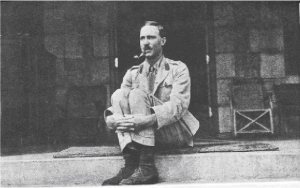
Colonel Richard Meinertzhagen
There is an amusing anecdote about him, probably fictional, that he met Adolf Hitler in his later years and was bemused when the fuhrer raised his hand in the sharp Nazi salute and declared ‘Heil Hitler!’ Supposedly Meniertzhagen returned the salute and said, ‘Heil Meinertzhagen!’
But back to the Happy Valley Set.
One of the most famous members of the Set was American socialite Kiki Preston, an heiress of the Vanderbilt family. Nicknamed ‘The Girl With The Silver Syringe,’ she was famous for her public use of morphine, cocaine and heroin, and was an avid big game hunter, along with her cuckold husband, Harvard alumn Gerry Preston. Sort of a roaring twenties version of Paris Hilton – famous, or rather infamous for her extravagances (and not much else).
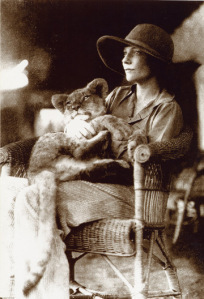
Countess Alice de Janze with Samson
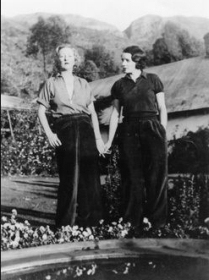
Indina and Alice
In a similar vein was Countess Alice de Janze, another American socialite nicknamed ‘the wicked madonna,’ married (ostensibly) to Count Frederic de Janze. She spent her days playing the ukelele and caring for her tame lion cub, Samson, and her nights with The Earl of Erroll, Josslyn Hay (who some say wound up murdered by her hand in the early nineteen thirties), or any number of men and women. Alice was an unpredictable firebrand who kept her marriage entirely open. Yet when her paramour Raymond de Trafford bowed to pressure from his traditional Catholic family and announced he would not marry her after she left the Count for him, she shot him in the stomach in a Paris railway station, then turned the gun on herself (and ‘shot herself gently’ according to one newspaper). Both survived, and Alice got her way. She and de Trafford were married a year later!
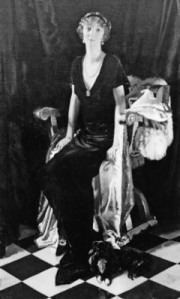
Idina Gordon
Lady Myra Idina Hay nee Gordon, nee Wallace, nee Sackville (at one point wife of the aforementioned Josslyn Hay), hosted wild, cocaine and alcohol driven wife-swapping parties at her mountain home, Clouds. She was renowned for greeting visitors as she emerged dripping from her immense green onyx bath.
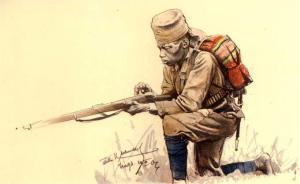 Now against this background, my Captain Howe, very much in with the in crowed, describes to the shadowy members of the Bell Club an incident in which he led a party of socialites into the bush after a wounded lion with eight Maasai askari hunters, and stumbles across something much more dangerous.
Now against this background, my Captain Howe, very much in with the in crowed, describes to the shadowy members of the Bell Club an incident in which he led a party of socialites into the bush after a wounded lion with eight Maasai askari hunters, and stumbles across something much more dangerous.
The basis for the weird in my story is the legend of the watusimba.
In the 1940′s, there were reports of young women who were enslaved via narcotics to East African witch doctors, forced to live in cages and given raw meat (sometimes human) to eat. These women were supposedly given lion skins to wear and claw-like weapons, then directed as assassins against the witch doctor’s enemies. They were known as watu Simba (or invariously, simba mtu), or were-lions.
Another story I took inspiration from was that of legendary big game hunter George Rushby, who as game warden of Taganyika, was called to deal with a pride of twenty two killer lions who killed and eaten approximately 1,500 people in the districts of Njombe and Singida. Battling not only killer lions, Rushby came face to face with local superstition as well, as the villagers believed the lions were magically directed by the will of a local witch doctor, Matamula Mangera, who was called The King Of The Lions.
Here’s an excerpt -
“It was an intimate party. Only myself, two gents with their wives, eight askaris…ah, that is, guards, culled from the Maasai, and about fifty Kikuyus, including the cook, bearers, and horse trainers. Quite a small entourage, really, for a hounding party.”
 “Huh-huh-hounding pah-pah-party?” asked another of the unseen audience, this one a man, younger than Bertrand, it sounded like, and a bigger stutterer than Moses.
“Huh-huh-hounding pah-pah-party?” asked another of the unseen audience, this one a man, younger than Bertrand, it sounded like, and a bigger stutterer than Moses.
“Yes sir,” I said. “Like your fox hunt, but we use gundogs. African Lion Hounds. Bloody beautiful animals, stiff ridgebacks and fine red coats, like proper British soldiers, bred for the purpose. They flush ‘em out, keep ‘em at bay till we can come up with our Express Rifles and blast ‘em.”
I took a sip of scotch and went on.
 “Anyway, the dogs had surprised a lioness with her kill, and they surrounded her. You could hear the barking and her roar way at the back of the train, a real hullabaloo boiling over. She killed two hounds by the time we got to her. Big, yellow thing she was, magnificent, her shoulders and her whiskers painted red with blood. Gerry shot her first with his .404 Jeffrey, right there,” I said, pointing to my own left shoulder. “Clipped her just enough to make a blood trail for us to follow, really.
“Anyway, the dogs had surprised a lioness with her kill, and they surrounded her. You could hear the barking and her roar way at the back of the train, a real hullabaloo boiling over. She killed two hounds by the time we got to her. Big, yellow thing she was, magnificent, her shoulders and her whiskers painted red with blood. Gerry shot her first with his .404 Jeffrey, right there,” I said, pointing to my own left shoulder. “Clipped her just enough to make a blood trail for us to follow, really.
Of course, most of the Maasai wouldn’t follow. They’re against killing a lioness unless out of necessity.”
I recalled arguing with the Maasai, when Kiki and her husband Gerry and Malcolm and Bernice rode up to see what was the bother.
It was barely noon, but we were all of us drunk already, and Kiki and Bernice were giggling as Gerry sloshed most of a bottle of gin over the lip of her glass, it being deucedly hard to pour on horseback.
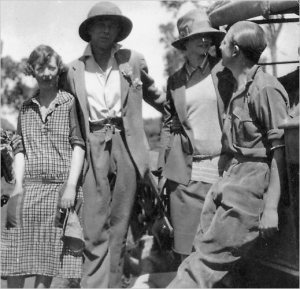 “What’s all the hubbub, bub?” Gerry snickered.
“What’s all the hubbub, bub?” Gerry snickered.
I waved my hand dismissively at Leebo, the headman.
“Ah, these black devils don’t want to chase her. Something about the area they don’t like. They’ve just got a thing against killing females.”
“Aw, that’s so chivalrous of them,” Bernice remarked, pouting her lips. She reached down and patted one of the bearers’ heads, even though it was the askari who were refusing.
“Yeah, knights in shining loincloths,” Gerry remarked.
“Won’t kill females,” Malcolm grumbled. “How little they understand the fairer sex, eh Ger?”
“I think it’s sweet,” Bernice said, now twisting her finger in the African’s curls. “Tell b’wana,” she cooed silkily, to the man’s obvious embarrassment.
“It’s bibi, for you, you numbskull,” Gerry snickered, shaking his head. “Bea, you’re scandalous. What’s it gonna take to get them moving, Cap?”
“Well the bearers’ll stick with us,” I said, “but half the Maasai won’t go.”
“Bullshit!” Gerry snarled suddenly. “We’re payin’ them aren’t we? Listen up, you apes….”
“Oh, let ‘em be, Gerry,” Bernice said, knocking back her glass and wiping the hand that had been stroking the Negro’s head on her khaki riding pants. “They wouldn’t be any help anyway.”
“She’s probably right, Gerry,” I allowed. “No help at all’s better than reluctant help in this case.”
“Oh but I so wanted a lion skin for the sitting room,” Kiki whined.
“I don’t know, tootsie wootsie,” I said. “Going into the bush after a wounded lioness with half the askari…”
“Can’t you all just see me laid out on a lion skin in front of the fire?” she mused, stretching suggestively in her saddle and lacing her fingers beneath her chin like a calendar girl.
“Can’t I!” I grinned.
“Oh brother,” Bernice said, rolling her eyes. “Theda Bara over here.”
“Well let’s send these wogs packing, and press on, chums,” Malcolm said, draining the last glass and tossing it over his shoulder.
 As I explained to Leebo the headman that I was discharging him, Kiki let out a wail.
As I explained to Leebo the headman that I was discharging him, Kiki let out a wail.
“What’s the matter?” We all of us asked at once.
She was rifling through her bag and I knew right away what it was, because the hard little velvet lined case that contained her famously silver syringe was already in her hand.
“I don’t have anything! Not a bindle!” she screeched, throwing things out of the purse.
“Aw, daddy’s little hop-head can’t get snowed for the big bad lion?” Bernice sneered.
“Shut up, you bitch!”
“Now now,” said Malcolm.
“Kiki,” I said, “you don’t really wanna go after a lion on that stuff do you?”
“That’s easy for you to say, Cap, you’re already plastered,” she snarled.
“Oh and you’re not?” Gerry prodded.
I knew I was. I had lost count of the bottles we’d left lying in the bush behind the train. Wine, scotch, absinthe, vodka….
“Well I’ll just have to go back and get Beryl to fly toNairobiand get some more,” she said, turning her horse around.
“Hey Kiki, what about the lion?” I called.
“Oh bring it back for me won’t you, Cap? I’ll give you a big kiss!” she called over her shoulder as she bounced away.
“Better give me more than that,” I called after her, watching the swell of her hips.
“Hey, that’s my wife you’re talking about, you limey profligate,” Gerry grinned, his eyelids wavering.
“I’m surprised you got that word out in your condition. Go catch her before she rides off a cliff,” I said.
He smiled and winked at me as he turned his horse toward the back of the train.
“Bag her for me, Cap.”
“Clean up your mess, you mean,” Malcolm shouted after him as Gerry joined the sacked askari heading home with their spears over their shoulders.
“Yes,” I chimed in, “if you’d of shot straight to begin with we’d be back at the Count’s laying around playing sheik andShebaright now.”
“Gimme a break, chum,” he said in parting. “I’m drunk.”
“Well,” said Malcolm, once they’d gone. “A hunting we will go.”
—–
You can pick up Tales From The Bell Club here, and see the old gang get what’s coming to them…








June 7, 2012
Four In The Morning Free On Amazon Till Friday
Hey all, just a very quick note this time around to let you know Four In The Morning, the dark fiction collection I did with authors Lincoln Crisler (editor on Corrupts Absolutely?) , Tim Marquitz (author of the Dawn of War Trilogy), and Malon Edwards, is available on Amazon (ebook and Kindle) completely free until tomorrow, Friday the 7th.
My weird gangsta novella of dark powers and cannibalism, Gully Gods, is contained therein. Read all about that (including an excerpt) right (here).
And you can pick it up right here – - http://www.amazon.com/Four-in-the-Morning-ebook/dp/B0084N3I1I/ref=sr_1_2?ie=UTF8&qid=1339092475&sr=8-2
Or in paperback for $8.99.
Hasta later.
-Ed








June 6, 2012
DT Moviehouse Reviews: Aliens
Continuing my blog feature, DT Moviehouse Reviews, in which I slog my way alphabetically through my 200+ DVD/Blu-Ray collection (you can see the list right here) and decide if each one was worth the money, here’s my take on James Cameron’s celebrated Alien sequel, Aliens.

(1986) Directed by James Cameron, Screenplay by James Cameron, Story by Walter Hill and David Giler.
Tagline: This time it’s war.
What it’s about:
57 years after the original Alien, navigator Ellen Ripley’s (Sigourney Weaver) life pod drifts into deep space and is picked up by a group of salvagers. She awakens from her overlong hypersleep (with Jones the cat) on Gateway Station in orbit above the earth, where company man Carter Burke (Paul Reiser) debriefs her on her predicament. She is stripped of her piloting license over her admitted detonation of the Nostromo and her testimony about the alien that killed her crew goes ignored. The planet where the Nostromo picked up the alien is now LV-426, a terraforming colony of over a hundred fifty souls who has never reported any encounter with any hostile organism. Then, almost as if Ripley’s awakening has roused the aliens, the Company loses contact with the colony. Burke approaches Ripley about going back to LV-426 with a contingent of Colonial Marines to act in an advisory capacity. Plagued by nightmares, she finally agrees, and sets out with a platoon of heavily armed but cocky troops to investigate. They find the colony partially destroyed and deserted but for a small girl, Newt (Carrie Hen), who survived the alien onslaught by hiding in ventilation ducts. And then the motion trackers start beeping….
Why I bought it:
Simply put, I know this movie from “Bio-readouts are all in the green” to “High-firmative.” When I first discovered it on HBO around 1987 or 88 I must’ve watched my VHS recording of it in a constant loop for a couple weeks.
As I said in my Alien review, I had never seen the original prior to this, but this induced me to first read the Alan Dean Foster novelizations of both movies, and then see the original movie.
So which is better? Well, it wholly depends on who you are, what kind of story you’re in the mood for. My personal favorite (and it’s gonna sound like a copout) is whichever one I happen to be watching. Alien is mood and tension. It’s a cold, detached sci-fi horror movie. Aliens takes that tension and flicks it like a taut rubberband. It’s an amusement park ride. It’s a thrilling, kick ass action movie in the vein of Predator (which is why the crossover between the franchises always seemed so inevitable) and Rambo.
But at its core, it’s got more heart than Alien. In fact, Alien is like Ash, the synthetic humanoid in that movie. Cold, analytical, calculating and cruel. Aliens is Bishop (Lance Henricksen). Artificial sure, but with a strong humanistic streak that you’re not quite sure is genuine until the end.
It’s been said a million times by better critics than me, but the soul of Aliens is the relationship between Ripley and Newt. A surrogate mother and an orphaned daughter. Ripley is Soft Mother and the Alien Queen is Wire Mother and they’re at war over Newt. All the posturing of the Marines, the excellent violent action, is tertiary to this conflict.
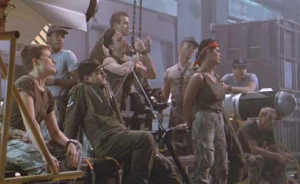 Now when I was twelve years old, I didn’t see that. It was all about the Marines, so allow me to channel my younger self and gush a bit.
Now when I was twelve years old, I didn’t see that. It was all about the Marines, so allow me to channel my younger self and gush a bit.
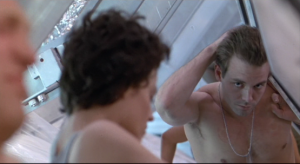
Oh Hicks…you look just like I feel.
Corporal Hicks (Michael Biehn, who I’m pretty sure I had some kind of man crush on in my formative years – it was his Kyle Reese in Terminator that got me wearing a trenchcoat in high school, not any misanthropic ‘mafioso’ devotion to sheer outsider-ness), brilliantly loud mouthed Hudson (the inimitable Bill Paxton who my friends and I used to just laugh at whenever we saw him anywhere – now I can see what a great, affable actor the dude is – and a director! Have you seen Frailty???), kick ass Latina lesbian Vasquez (Jeanette GOLDSTEIN – yeah, in my youth I had no idea. But Joel Grey as Chiun fooled me for years – my Remo Williams copy had been recorded on SLP and was pretty blurry), hard bitten Sgt. Apone (Al Matthews), and their stick up his ass, over his head, but ultimately heroic leader Lt. Gorman (William Hope), to say nothing of Crowe, Frost, Wierzbowski, Drake, Dietrich, Spunkmeyer, and Ferro.
Yeah and that was without opening another window. Entirely from memory. How many movies are there where the minor characters (and I mean so minor they’re introduced and they die in the span of about a half hour) are memorable enough that you can name them all? Given a little time and space I could probably attribute each character to their lines (except for poor old T. Crowe, who I don’t think had any).
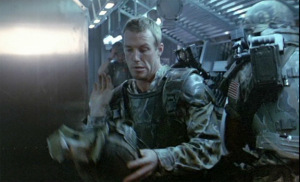
Private T. Crowe….the quiet one.
That’s a testament to the writing and the acting in Aliens.
You take to the Marines almost immediately. They’re cocky, self-assured, gung ho jackasses all, with Hudson reigning supreme. Hudson is the loudmouth complainer every job, every sports team has. The guy that if you work with him you’re either shaking your head at his antics or turning around and telling him to shut the hell up already. They don’t believe in the aliens (xenomorphs, as Lt. Gorman calls them) any more than the company does, and though they quickly discover evidence of their existence, in true post-Vietnam war movie fashion, as soon as they come face to face with the enemy, their technology amounts to a precise ratio of doodly/squat. In fact, they’re thrown into an utter panic, three quarters of them die outright (in a memorable scene, Lt. Gorman stares at his remote mission monitor in disbelief as a marine’s bio readouts flatline before his eyes.) like stormtroopers against Ewoks, like the US cavalry at Little Big Horn.

We ain’t in space. Scream all you want.
The aliens literally emerge from the hive walls in which the colonists are found cocooned and snatch them one by one. They even torch each other in their confusion. And you realize that although you’ve been waiting for this to happen the entire time, you’re suddenly saddened to see the unit get their asses kicked so thoroughly. Going back and seeing the first Alien, there’s a definite added thrill in knowing how tough to kill one xenomorph was on a single ship and then seeing a slew of them cut loose with an entire colonial outpost to hide in.
But then Ripley comes in, piloting God knows how many tons of armored APC through the wall and Hicks musters the broken survivors and they spin wheels the hell outta there, running down aliens and sending their acidic blood spraying everywhere in the process. Ripley comes into her own in this scene. In Alien, as I said, she came off a bit cold and unlikeable, but in Aliens, as soon as she comes in contact with Newt, the orphan girl, we see a side of her we didn’t see in Alien, and she’s a stronger and more interesting character. There’s a great moment after their initial meeting where they’re watching the Marines’ camera feed of the hive interior and Ripley sees the people cocooned in the walls. She immediately tells Newt to leave the viewing area, like a parent who knows something inappropriate is coming (and it does).
The music in the forementioned ambush scene is my favorite in the whole movie. James Horner apparently felt Aliens was a rush job, but he really turned in some great work here. The music is alternately rousing and eerie.
I also have to talk up the technical aspects a little. Aliens is slicker looking than Alien, but it makes sense, and not just because we’re in the 80′s now. We’re fifty years more into the future, and we’re mainly aboard a military ship, which you have to assume is kept cleaner and more presice than a commercial towing rig. Go on the bridge of a cargo ship and compare it to the bridge of a Navy vessel and you’ll see what I mean. The Marines’ gear is functional and believable (the personalizations scrawled on their guns and armor and helmets are cool touches), with the mecha-suit loader and the rapid sound of the pulse rifles being a particularly imaginative standout. Futurized enough to plant us firmly in sci-fi territory, but readily idenitifable as to each thing’s purpose.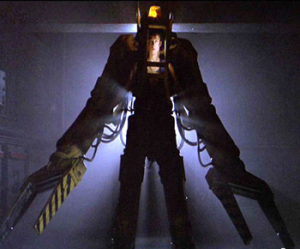
Most of the menacing subtleties of lighting in Alien are exchanged for more dramatic and mood enchancing reds and blues (LOTS of blue - I’d lay money on what Cameron’s favorite color is…and Michael Mann’s too). But it all comes together nicely.
In rewatching it, I noticed this time around how many tricks Cameron used to great effect. I saw the same alien blow apart maybe three times, and you rarely see more than four aliens on screen at a time (and then only briefly), yet you really get the sense there are hundreds slavering in the shadows. Lots of reaction shots. I guess Cameron was working under a lot of constraints, monetary and professional (he had notoriously bad relations with the British crew), but he proves himself a massively talented and ingenious filmmaker, just as he did with the relatively low budget original Terminator.
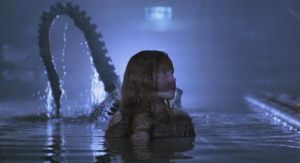
They mostly come out at night…mostly.
The alien queen is a brilliant piece of puppetry, the real ‘money shot’ of the movie. The practical FX in this film are heads and shoulders above most CGI stuff you see nowadays. There’s just something about seeing a real person go head to head with something right there in front of them in the same light that can’t be topped. Hicks rolling backwards to ‘carry’ a leaping alien on a bed of automatic fire, or Vasquez pinning one of the things to the side of the shaft with her boot and firing point blank into its head, or (of course) Ripley in the loader ducking back as the queen’s jaws come snapping at her face. All infinitely more visceral and engaging than watching what’s essentially a video game cut scene.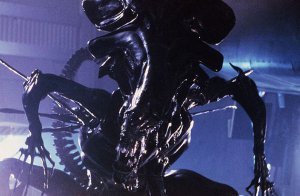
You get another fake out ending in the tradition of the first Alien, and it’s a doozy. All in all it’s a brilliant addition to the franchise, probably the one that really insured its future.
And don’t get me started on the stuff Aliens has inspired in look and story. Surely a whole generation of FPS video games owe their plots and feel to Aliens.
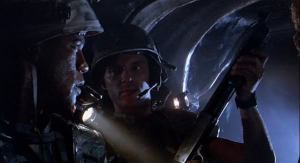
“I like to keep this handy…for close encounters.”
A word on the Director’s Cut. It’s a little overlong and makes the pacing hiccup a bit. There is some absolute gold in there in terms of character development. We learn Ripley had a daughter who died on earth two years before she is rescued from the lifepod, and this greatly informs her character, ehancing the relationship with Newt. At the same time, we see the colony (Hadley’s Hope) in full bloom of activity, learn a little bit more about Burke’s treachery, and best of all, see Newt pre-disaster, as her parents stumble upon the same derelict spacecraft and unwittingly unleash the xenomorphs. There’s a cool little time waster with the Marines setting up a bunch of robot sentry guns to discourage the aliens from overrunning them. Nothing much gained, but a neat sequence, and again very much on the cheap. We’re literally watching ammo counters click down and hearing the bullets and alien screeches. That’s it. But still a tense scene. There’s a short but sweet parting exchange between the acid-burned Hicks and Ripley before she goes off to rescue Newt and he succumbs to painkillers. Though it does seem just a tad out of place considering the situation and the breakneck progression of the sequence, it’s nice to hear them exchange first names, something we don’t canonically get in the rest of the movie. It’s also a proper goodbye to Hicks. Finally there are some slight dialogue additions here and there, and what I have to admit is a kind of embarrassing sequence with Hudson regailing Ripley on their armaments in the drop ship. One too many uses of the word ‘badass.’
Anyway, let’s hope Prometheus is even a third as good as Alien/Aliens.
Now you’ll notice Alien 3 is NOT next in my queue. You won’t find it or any of the other entries in the series in my collection. While I like David Fincher (Se7en is amazing, and Alien 3 really isn’t a bad movie, per say), Alien 3′s opening totally rips the heart out of Ripley’s storyline. By killing Ripley’s hardwon surrogate family offscreen, the producers pretty much destroyed any interest I had in seeing Ripley any more. They very cheaply SNAFU’d her character progression, and actually tried to set her back on her own emotional timeline. It just doesn’t work, and worse, undercuts all the great drama of this movie. There’s also a major leap in logic involving an egg somehow making its way onto the Sulacco that I just can’t forgive. And I won’t even mention the abyssmal Alien: Resurrection. For me the series ends here and picks up again with Aliens vs. Predator.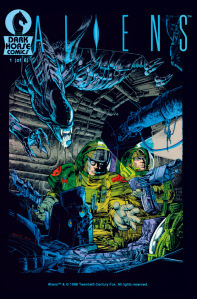
For a better continuation of the series post Aliens, I’d heartily recommend Mark Verheiden’s ‘Aliens’ comic book, published in the very early days of Dark Horse, before Alien 3. In that comic, you get a grown up and deeply disturbed Newt, a scarred and angry Hicks, a great take on the space jockeys, and a simultaneous invasion of the aliens’ homeworld by a troop of synthetic marines led by Hicks AND contamination of the earth by the aliens (due to a really fascinating subplot involving religious zealots stealing the alien from a government facility and willfully impregnating themselves). The first two volumes have some amazing writing, and it really takes the series in much more natural progression, though I think it would’ve benefited from the presence of Ripley earlier on – she doesn’t appear until much later, and by then Alien 3 had been announced and the continuity was already on its way to being abandoned. Newt’s and Hicks’ character names were actually changed in later reprints!
Best bit of dialogue:
There are great lines galore in this movie but my favorite is at the commissary table on the Sulaco just after Bishop does his knife trick with Hudson. Early in the meal Spunkmeyer throws down his food and exclaims ‘What’s this crap supposed to be?’
FROST: Cornbread, I think.
HICKS: It’s good for you boy, eat it.
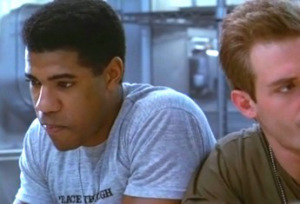 While at the big boy’s table, Bishop sits down and observes a trickle of milky synthetic blood running from a nick in his thumb. Ripley is instantly upset, remembering her violent encounter with Ash in the first movie. Bishop tries to placate her by assuring her it’s physically impossible for him to harm a human due to his programming. He passes her a tray of food and she angrily slaps it out of his hand with a huge clang, drawing the attention of the other Marines.
While at the big boy’s table, Bishop sits down and observes a trickle of milky synthetic blood running from a nick in his thumb. Ripley is instantly upset, remembering her violent encounter with Ash in the first movie. Bishop tries to placate her by assuring her it’s physically impossible for him to harm a human due to his programming. He passes her a tray of food and she angrily slaps it out of his hand with a huge clang, drawing the attention of the other Marines.
RIPLEY: Just stay away from me, Bishop! You got that?
The Marines return to their dinner.
FROST: Guess she don’t like the cornbread either.
Best scene:
The second alien attack in the colony’s Operations Center. The surviving Marines and Ripley, Newt and Burke had welded the corridor doors shut and are confident they have blocked off every possible way in.
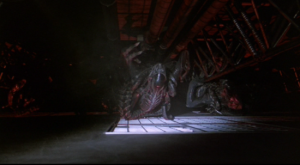
There must be something we missed….Something not in the plans.
Hudson’s motion tracker start beeping off, multiple little flashing dots, and he counts down the meters as the tremendous body of creatures advances. They huddle up and lock and load their weapons, watching the door, the only possible entryway, waiting for the impact of the creatures. Six meters, and Ripley declares….’That can’t be – that’s inside the room!’ Still, the signal gets closer. Necks crane to the ceiling, and the sinking feeling is palpable. Hicks grabs a light and climbs up on a desk, poking his head through the vent, illuminating a shaft crammed with aliens, crawling silently forward on the walls, floor and ceiling.
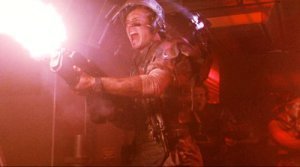
“Come on you bastards! Come on you too! Oh you want some of this?”
The close action sequence that follows as the aliens crash through the ceiling sees the rapid deaths of Hudson (one of the most memorable and surprisingly game bow outs I’ve ever seen in an action movie – for all his bitching and moaning he goes out like a boss), Burke, Vasquez and Gorman.
Would I buy it again? Yes.
Next in the queue: The Apostle








June 1, 2012
DT Moviehouse Reviews: Alien
Continuing my infrequent blog feature, DT Moviehouse Reviews, in which I slog my way alphabetically through my 200+ DVD/Blu-Ray collection (you can see the list right here) and decide if each one was worth the money, here’s my take on the movie that kicked off the Aliens franchise, Alien (coincidentally just in time for the release of this movie’s supposed prequel, the much-anticipated Prometheus).
(1979) Directed by Ridley Scott, Screenplay by Dan O’Bannon, Story by Ronald Shusett
Tagline: In space, no one can hear you scream.

What it’s about:
Sometime in the far future the crew of the Nostromo, a deep space commercial towing vessel, awakens from their months long sleep to respond to a signal beacon on a nearby uncharted planet. Three of the crew members, Captain Dallas (Tom Skerrit), Lambert (Veronica Cartwright), and Kane (John Hurt) explore the source of the mechanical beacon, an alien spacecraft with a dead extra terrestrial pilot (the mysterious space jockey purported to be the basis of the new movie Prometheus) and a payload of eggs. A creature hatches from one of the eggs and attaches itself to Kane’s face, impregnating him with a savage predatory organism which gestates and then bursts from his chest, stalking the crew among the labrynthine corridors of the monolothic starship.
This is a seminal work of science fiction horror. I only saw stills and commercials of this movie as a kid in the seventies and it haunted me into young adulthood. How can a green glowing hen’s egg conjure such dread in a kid? Maybe it was the eerie music by Jerry Goldsmith in the commercials. I actually saw the sequel, James Cameron’s Aliens before I finally saw Alien, and for years I preferred it. I actually only saw Alien to enrich my ribald love of Aliens (and I read the Alan Dean Foster novelization before I even saw it). Now….well, I’m not sure. That’s a question to ask in answer in the next review, which is of that movie.
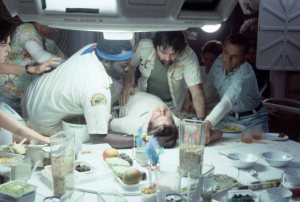 If there is such a thing as science fiction cinema verite, it’s Alien. The bizarre, unsavory subject matter is right out of an EC horror comic, but the movie works because it’s somehow entirely realistic and believable. The characters (played by an ensemble of extremely naturalistic and talented actors, all in their prime, all deserving a mention – Sigourney Weaver -in a star making debut- Harry Dean Stanton, Yaphet Koto, Veronica Cartwright and Ian Holm) mumble and engage in crosstalk, bitch about un-cinematic things like finder’s fees and payroll shares, and so look genuinely hysterical when one of their own suddenly keels over at dinner and expels a slithering toothy horror from his broken, bloody chest cavity (There’s an oft-repeated rumor that Veronica Cartwright had no idea the creature was gonna pop out – this isn’t entirely true. Obviously John Hurt is not actually laying on the table at the time of the burst, so you know there was a lot of FX set up – but the actors apparently weren’t warned about blood squibs going off and when Cartwright gets sprayed with fake blood, she apparently really did have a conniption). This is the only sci-fi movie I can think of where I’m drawn into a secure lull. Except for a few interjections of Goldsmith’s superb score (I can’t think of a good way to describe it – somehow ‘non-orchestral’), it’s actually like The Ballad of Gregorio Cortez in that I don’t remember I’m watching a movie in the first half.
If there is such a thing as science fiction cinema verite, it’s Alien. The bizarre, unsavory subject matter is right out of an EC horror comic, but the movie works because it’s somehow entirely realistic and believable. The characters (played by an ensemble of extremely naturalistic and talented actors, all in their prime, all deserving a mention – Sigourney Weaver -in a star making debut- Harry Dean Stanton, Yaphet Koto, Veronica Cartwright and Ian Holm) mumble and engage in crosstalk, bitch about un-cinematic things like finder’s fees and payroll shares, and so look genuinely hysterical when one of their own suddenly keels over at dinner and expels a slithering toothy horror from his broken, bloody chest cavity (There’s an oft-repeated rumor that Veronica Cartwright had no idea the creature was gonna pop out – this isn’t entirely true. Obviously John Hurt is not actually laying on the table at the time of the burst, so you know there was a lot of FX set up – but the actors apparently weren’t warned about blood squibs going off and when Cartwright gets sprayed with fake blood, she apparently really did have a conniption). This is the only sci-fi movie I can think of where I’m drawn into a secure lull. Except for a few interjections of Goldsmith’s superb score (I can’t think of a good way to describe it – somehow ‘non-orchestral’), it’s actually like The Ballad of Gregorio Cortez in that I don’t remember I’m watching a movie in the first half.
The FX and set design are made to compliment the performances, not perform themselves. Everything, though insanely complex (the coolant room in which Harry Dean Stanton’s character is killed looks like some kind of mechanical alien cathedral, or a room in Harlan Ellison’s ‘Martian Pyramid’), looks entirely lived in and functional, and no set piece ever really intrudes on the action.
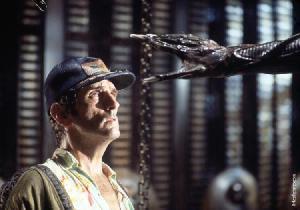 Brilliant acting and set design (and music) aside, the central piece of Alien is the xenomorph itself, designed by H.R. Geiger. The thing is indescribable. Part carpenter ant, part beetle, part lizard, part sexualized human skeleton. And it changes in subtle ways every time we see it. It’s horrific reproductive cycle speaks directly to the innate male discomfort with the human reproductive process itself (or at least, to mine anyway), and then perverts it to the extreme, rendering an instantly unforgettable image in the mind.
Brilliant acting and set design (and music) aside, the central piece of Alien is the xenomorph itself, designed by H.R. Geiger. The thing is indescribable. Part carpenter ant, part beetle, part lizard, part sexualized human skeleton. And it changes in subtle ways every time we see it. It’s horrific reproductive cycle speaks directly to the innate male discomfort with the human reproductive process itself (or at least, to mine anyway), and then perverts it to the extreme, rendering an instantly unforgettable image in the mind.
The scenes where the crew alternately hunts and flees from the growing creature in the dark bowels of this immense ship are methodical and claustrophobic, slowly building the tension to deliver maximum fright when something does happen. Perfectly directed. This may be the last hurrah of seventies cinema.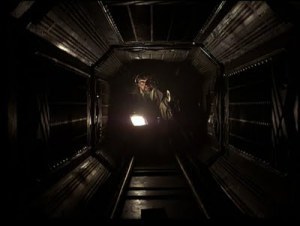
Also of note is the performance by Sigourney Weaver as of one of moviedom’s most believable action heroines, Ellen Ripley. She’s not quite the ass kicker she is in Aliens here, but by the end of the movie she’s well on the road. She’s already a bit of a ball cracker, and it’s cool that the script has the daring to make her not entirely likable. Stanton and Kotto’s affable engineers don’t much care for her, and at first audience sympathy naturally sways against her. She’s the one who wants to play by the book and keep the infected Kane off the ship, despite it coming off as inhumane. Ian Holm’s Science Officer Ash instead lets him in, but it becomes obvious that he wasn’t motivated by his humanity…in a shocking later scene in which Ripley discovers he’s endangered them all on orders from the shadowy ‘company,’ we find he doesn’t have any to speak of.
As a matter of fact, it’s at that point that sympathies really start to swing toward Ripley as a character and as the heroine of the movie. Her percieved cold bitch facade drops tearfully in the face of Ash’s uncrupulous android. I love Holm’s detached creepiness. He comes across as out of touch with everybody else, possibly due to the nature of his job, or perhaps due to some social or scholarly standing (noticeably, he’s the only Brit aboard). There’s a great aside right after the alien kills Kane where Ash refers to it as ‘Kane’s son.’
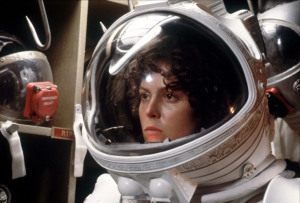 Then at last there’s the famous fakeout ending, which supposedly duped a lot of overeager-to-beat-the-parking-lot-traffic movie watchers into missing the real climax. It’s possible Alien singlehandedly created a generation of moveigoers who sit through the end credits….just to be sure.
Then at last there’s the famous fakeout ending, which supposedly duped a lot of overeager-to-beat-the-parking-lot-traffic movie watchers into missing the real climax. It’s possible Alien singlehandedly created a generation of moveigoers who sit through the end credits….just to be sure.
I’ve seen both the theatrical version and the director’s cut of this movie. Scott prefers the original. I guess I do too, but it’s interesting to see Ripley’s discovery of the cocooned Dallas, and I don’t know who Veronica Cartwright pissed off, but every single scene that gives her mainly shrill and panicky character depth wound up on the cutting room floor, so it’s worth watching to see Lambert shine.
Best bit of dialogue:
This is a tough one. As I said, the dialogue is so natural it’s hard to pick out any real Hollywood lines. I guess the closest is in the scene immediately after the decapitation of the company android Ash. Parker wires up his paste and lubricant covered head on the table top, and the reanimate but harmless Ash answers a few questions about the nature of their mission and what he knows about the alien. He admits to deliberately seeking to impregnate the crew and deliver the specimen to the company, and even allows that he ‘admires it’s purity.’
He winds up the revelations with -
‘I can’t lie to you about your chances…but you have my sympathies.’
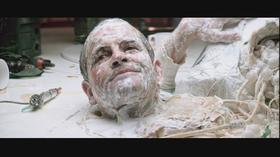
‘He’s a robot! Ash is a goddamn robot!’
And then a ghoulishly patronizing grin spreads across his face and Parker knocks loose his power source and torches the synthetic flesh off his artificial skull.Best scene:
[image error]
‘Nuff said.`
Would I buy it again? Yes
Next up in the queue: Aliens








May 29, 2012
Van Helsing In Texas Places Third In JournalStone’s $2,000 Advance Contest
http://journalstone.com/contest/journ...
Van Helsing In Texas has placed third in the JournalStone Advance Contest for 2012, which means you’ll likely see it coming your way by the end of the year.
The premise is based around a series of found historical documents, personal papers written by Professor Abraham Van Helsing himself.
Following the events of Bram Stoker’s Dracula, Professor Van Helsing checks himself into Jack Seward’s aslyum in Purfleet, suffering from violent recurring phantasies centering around his destruction of the Count’s vampiric brides and involving Mina Harker. Seward diagnoses the professor with melancholic lycanthropea and treats him. Upon his release, Van Helsing visits with Arthur Holmwood and learns the cremated remains and personal affects of Quincey P. Morris (who died at the hand of Dracula’s gypsies) have not yet been returned to his family ranch in Sorefoot, Texas. He immediately volunteers to do so, thinking a holiday will do him good.
In Texas he finds Quincey’s brother Coleman embroiled in an escalating land dispute with a neighboring outfit of Norwegian cattlemen led by the enigmatic Sig Skoll. To exacerbate things, a rabid mountain lion is slaughtering livestock. When the sheriff and one of Cole’s hired hands turns up murdered, Van Helsing suspects a supernatural culprit.
Is as real life shapechanger on the loose? Or a bizarre murder cult? Or are these signs but the product of Van Helsing’s own previously disordered mind? The professor must sort out the truth soon, for the life of Skoll’s beauteous new bride may be in danger….
Look for it in November from JournalStone….








May 23, 2012
Music To Murder By: Aural Pleasures In Gully Gods, The Crawlin’ Chaos Blues, And The Merkabah Rider Series
A lot of writers I know talk about the music they listen to while they write, how it inspires them. I have never been musically inclined and I need almost total silence to write most of the time. I find music distracting, particularly if it has lyrics, or if I associate it with something else, like a movie soundtrack or something.
There have been three notable exceptions, Gully Gods (from Four In The Morning) The Crawlin’ Chaos Blues, and Merkabah Rider.
I still don’t listen to music while I’m writing, but for these three works there are certain songs I’ve found myself listening to (usually in the car) to get me in the mindset. Particularly for Gully Gods and Crawlin’ Chaos, which both mention a couple of these tracks in the body of the story.
‘It was real hot that night, August in Houston. Me and B and Cripto was chillin’ in the Subway parking lot smokin’ beedies and eatin’ footlongs over the trunk of his ride (a tricked out two toned black and grey’92 Buick Roadmaster nigga called The Batmobile – had chrome bats on the dub spinners) and listenin’ to ‘Face when a pickup full of Southside Cholos pulled up and got out…’
‘Face is Brad T. Jordan, the Houston rapper Scarface, formerly of the Geto Boys. If you’ve seen Office Space you’ve heard him. Apparently like me, Mike Judge is a big fan. He even appears as the pimp Upgrayyde in Judge’s Idiocracy.
Something about Scarface’s voice and delivery reminds me of one of my all time favorite musicians, Chester Burnett AKA Howlin’ Wolf. But I’ll talk about him later. Like the Wolf, Scarface has a distinctively deep voice, almost like a minister’s. I would call him a minister of rage and darkness. His lyrics are vivid and emotionally evocative (‘I’ve got this killer up inside/of me I can’t talk to my mother/so I talk to my diary – and ‘Outside I see the cop cars flashin they lights/Raindrops symbolizing God is saving the life/The sun shining so they say the devil beatin his wife/The body bloody underneath the sheet is waitin for Christ/The streets is hungry- so I know they watchin -waitin to strike/But anything you ever got for easy came with a price’), and he swings wildly from violent, reprehensible glorification of a violent life, to deeply spiritual condemnation – but in the latter, never preachy or accusatory. He’s a pioneer of the southern Dirty South sound, something the movie Hustle & Flow portrays pretty well.
The song J-Hoss and Bruce Wayne are listening to in the parking lot is an old but a goody that sets the tone for the entire novella – Scarface’s Never Seen A Man Cry Till I Seen A Man Die -
Another one from Scarface that I listened to again and again and sort of informed the mentality of my protagonist and the various characters was G-Code -

‘She so damn fine. She move perfect. Like a curtain in the breeze, her hips be swayin.’
She smile and come in close and we be grindin’ up against each other. She smell real good.
“You like this music?” she ask. She got to lean in close and talk in my ear, and her breath is hot and sweet like gum.
“Uh huh,” I say. “It’s old ain’t it?”
“Yeah,” she say. “A couple years. Tres Delincuentes. You know what they’re saying?”
She cross her wrists behind the back of my neck and watch me and I put my hands on her waist, feel it sliding side to side, warm under my hands.
“Uh uh,” I say.
The song in this passage is Delinquent Habits by Tres Delincuentes. It’s kind of a West Coast Mexican hip hop tune, but it’s a great party song. I love the incorporation of the mariachi brass.

‘Then I hear the music. It ain’t from the party. It’s this heavy 808 thumpin,’ comin’ down the ave. Ain’t no oompa doompa, neither. It’s somethin’ old school. Familiar.
I turn my head, cheek to the street, and see a pair of headlights comin’ slow down the block. Brights be on, bright as a pair of suns. They higher off the ground than a car.
It stop a couple feet away.
All of us be in the headlights, but nobody lay offa me. They just all of ‘em turn and look.
The doors open and the music gets louder. I ain’t heard that shit in forever. It be The D.O.C. My pops used to play that shit in his ride. Ridin’ with him with the stereo bumpin,’ be one of the only memories I got of him.
A couple dark shapes get out and stand in front of the headlights. Them lights is so bright you can’t see shit but two motherfuckers standing there like a couple of shadows.’
The song in this passage is ‘It’s Funky Enough’ by the D.O.C. It’s pretty old, but I figured the Liberians might’ve just been getting into it. It’s got a menacing beat, very aggressive sounding, well suited to the scene, but it’s probably one of the most G-rated songs on this page, funny enough. The D.O.C. is one of hip-hop’s great tragedies. He did one promising solo album and promptly lost his voice in an injury sustained in a car accident. He’s gone on to be a successful producer and I heard he might be at last getting some kind of corrective surgery this year.

Stallone and Merciless throw Pocho in the chair and grab hold of him. Gravefilla take the guns over to a table and start layin’ ‘em in a drawer.
I go over with the pliers. The brown brown make me feel like this a video game or somethin’ – like I ain’t even in my body. I ain’t even doin’ what I doin.’
Hitler turn on the boombox, and some heavy shit old school shit come thumpin’ out. Music to murder by.
“Yo, fuck you mayates,” Pocho yell. He sound all fucked up ‘cause his teeth busted. “You just better fuckin’ kill me. ‘Cause I get loose I’ma kill me some niggers.”
I reach out with the pliers and I catch that piece of skin and bone between his nostrils. His whole body lock up like I got him by the nuts.
“You like movies, mayne. How you like the Three Stooges?”
For that scene I had two songs in mind. Firstly the Boston-born group Gang Starr and their Take It Personal. The world lost a real talent when MC Guru (Gifted Unlimited Rhymes Universal) passed away recently. Talk about your distinctive voices.

The other was NWA’s Real Niggaz Don’t Die – possibly one of the angriest, most intense and vitriolic mainstays in their catalog. If you’re easily offended, don’t click on this one.

I’ve already talked about Howlin’ Wolf’s influence on my Lovecraftian blues short story The Crawlin’ Chaos Blues over at Greg Mitchell’s blog. I hate repeating myself, so go take a look at it.
Back?
OK then.
Songs that show up in The Crawlin’ Chaos Blues -
When I first seen King Yeller, he was leanin’ on a beer sign watchin’ that Lake Street L clackin’ overhead, one bent Kool stuck in his lips, beatin’ out ‘I Ain’t Superstitious’ as best he could on a rusty ‘ol National with a pocket knife for a slide.
Crammed into the corner with a jumpin’ band was the man hisself, Howlin’ Wolf, all three hundred pounds of him, black as pig iron and sweatin’ like a steam engine, crawling on all fours, rollin’ his eyes, and flickin’ his tongue like a snake. He was wailin’ ‘Evil’ into a microphone and he sure looked like a man possessed by a devil. He was too big for the place, so goddamned big when he stood up and put his harp between his hands and blew he looked about to swallow it whole.
Yeller had picked out one of them fine biscuits in the crowd and was singin’ straight at her. She was that devil-eyed type woman lay her business on you, make you forget your own name, how much money you got in your pocket. She seen what Yeller was about right off, and she give him a smile over her man’s shoulder. That gap in her two front teeth let you know she liked to get her jelly rolled. He played ‘Come On In My Kitchen’ at her, and then ‘One Way Out,’ and by the time he finished up, her man had took notice.
Now for The Merkabah Rider series, there are a few tracks I listen to to put me in the mood, though of course, none of them actually appear in the books.
As you might suspect, most of them are Ennio Morricone pieces. In particular these.


And legendary bluegrass mandolin master Bill Monroe’s My Last Days On Earth. If any song encompasses the entirety of the series and the feel I’m trying to portray, it’d be this one.

My friend Ryan Gerossie also put together this book trailer using music we both composed and played (I did the Jaw harp and the monotonous guitar tune) for the indie film we did together in 2009, Meaner Than Hell (you can watch the trailer on the sidebar). This tune is sort of my default Rider theme (though if I had my way I’d find a way to mix some kind of klezmer or Hebrew chanting in there).

Anyway, listen. Broaden your horizons. Enjoy.








May 21, 2012
DT Moviehouse Review: The Agony And The Ecstacy
Continuing my infrequent blog feature, DT Moviehouse Reviews, in which I slog my way alphabetically through my 200+ DVD/Blu-Ray collection (you can see the list right here) and decide if each one was worth the money, here’s my take on The Agony And The Ecstacy.
(1965) Directed by Carol Reed, Screenplay by Phillip Dunne, based on the novel by Irving Stone
Tagline: From The Age Of Magnificence Comes A New Maginficence In Motion Pictures (blech!)
[image error]
What It’s About:
In 1508, warrior pope Julius II (Rex Harrison) commissions sculptor Michaelangelo (Charleton Heston) to paint a fresco of the on the ceiling of the Sistine Chapel, much to the latter’s chagrin (Michaelangelo does not consider himself a painter). As war breaks out with the French, these two monumental personalities bicker and battle, and a masterpiece is born.
Why I Bought It:
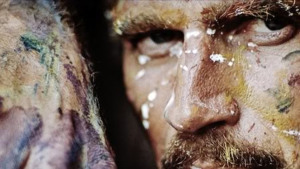
“It’s not blood that flows in Michaelangelo’s veins….it’s paint.”
Any one involved in the creative process should see this film.
I first saw it on AMC in my college years. I was living practically alone in an Uptown apartment in Chicago, mostly feeling sorry for myself and writing screenplays that to this day nobody has read and a few short stories and novels that some have.
The struggle of the artist to find inspiration, the frustration of achieving the desired work with the clumsy and inadequate tools at hand, the butting heads of the artist and the patron, and the deep rooted faith of Michaelangelo in contrast to Pope Julius II’s pragmatic approach to God resonated with me on a personal level.
The two main characters are fascinating. Harrison’s Julius is fiery and active, more soldier than priest. He dons the papal cloak over gilded plate armor, and ordains cardinals on the battlefield, with cannonades crashing all around.
Now I’ve heard a lot of criticism leveled at Charlton Heston over the intervening years between now and his unfortunate appearance in Michael Moore’s Bowling For Columbine. I think his stance on gun rights has colored a lot of peoples’ opinions on him, including (predictably) those who have never watched anything with him in it. John Wayne gets this a lot too – I don’t know how many times people have told me they hate John Wayne only to then admit they’ve never seen The Shootist or The Searchers.
Screw that. Heston has a magnificent screen presence. He’s tall as hell, and his resonating voice makes everything he says sound important. This is not his greatest performance (that would be either his iconic Moses or Judah Ben Hur), but he’s still arresting in the role.
Heston as Michaelangelo is obstinate, tempermental and subversive. Like the pope, he speaks his mind, and while most of the cast kisses Julius’ rings, Heston bows but looks into his eyes (I believe they’re the two tallest people in the entire cast, dwarfing spaghetti western vet Tomas Milian’s Raphael) while letting slip his protestations and criticisms. The two come to loggerheads over everything from agreed upon payment (or lack of) to subject matter.
In one scene Julius brings in his cardinals to view the unfinished ceiling, and while one shouts ‘obscenity’ and ‘blasphemy’ at the writhing naked forms (‘God Himself created man in his own image. He created him with pride, not shame! It was up to the priests to invent shame!’ he retorts), another, an armchair art critic, urges Michaelangelo to paint in the style of the Greeks.
In answer, Michaelangelo explodes. ‘Why should we paint like the Greeks?! I’m not different for the sake of difference, I’m different because I am different! I’m a Florentine and a Christian working in my time. They were pagans, working in theirs. We should surpass the Greeks!’ and ‘I will paint man as God conceived of him! In the full glory of his nakedness.’
To which Julius quietly declares;
‘The ceiling will remain.’
Julius created the Swiss Guard and organized the church militaristically, conceiving of it as not only ruling Italy from Rome, but acting as a kind of United Nations peacekeeping force, strong enough to mitigate peace between the warring nations of Europe and be respected. He was also a generous patron of the arts, and it’s implicitly stated in the movie that he hopes to perhaps counterbalance the sins of his life with great, divinely inspired works to ease his sentence in Purgatory.
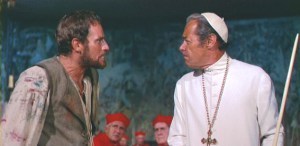
“When will you make and end??!” “When I’m finished!”
You get the sense that although they bicker, each admires and envies the other. Michaelangelo is an artist who models the Apostles after tavern drunkards he sketches on wine soaked tables, but he’s supremely introverted and looks always to heaven. Julius is a soldier and politician, a man of action, but he sees Michaelangelo’s gift as proof of divinity in man, a divinity he admits later that he rarely sees except through Michaelangelo’s paintings. The two have different views on God (there’s a great scene where Julius and Michaelangelo stare by candlelight at the famous rendition of God touching the newborn Adam’s outstretched finger, and Julius asks ’Is that really how you see Him?’), but a common admiration for the beauty of art.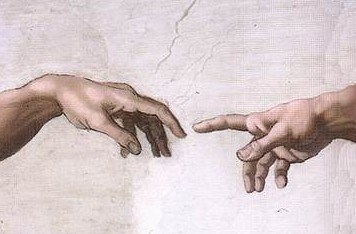
This is a 70mm movie and though it may feel a bit wasted on what’s essentially a bit of a stagey two man show, there are scenes where the format really shines, mostly when the ceiling of the chapel is shown. There’s also a really great eleven minute narrated opening showcasing Michaelangelo’s various sculptures as a means of putting his work into perspective. The Pieta is shown in great detail, the David, Moses, and various other works. In HD the intense realism of the statues jumps out at the viewer. Every supple curve of muscle and form, every fold of cloth. The narrator at one point says the statues don’t appear to be made of hard marble at all, but soft waxen sculptures, and you really do see that. They’re almost tear-inducing they’re so lovely. They do speak to a divinity, and argue better than any pulpiteer the existence of a soul in man.
Carol Reed, who directed one of my other favorites, The Third Man did this one. It’s not as daringly composed as the earlier film, but it’s great to look at, and really with what’s being depicted, the baroque architecture, the glorious costumes (Julius’ gilded armor is particularly memorable to me – you can see it a few times in the trailer), you really don’t need camera tricks and fancy lighting. Reed wisely stands back and lets the larger than life subject matter (and actors) do all the work.
Best bit of Dialogue:
The most famous exchange is the often repeated one where Julius constantly demands ‘When will you make an end?’ as the ceiling becomes more and more complex and Michaelangelo always replies simply ‘When I’m finished.’
My personal favorite has always been the solliloquy by Heston when the Countess de Medici (the criminally underused Diane Cilento) hints at her love to him and he confesses his inability to reciprocate. I think I was at the perfect stage in my life to hear this.
Michaelangelo: There’s no room in me for love. Maybe there never was. I’ve wondered about that. In Bologna there was a woman. A courtesan. Beautiful. I was attracted to her, I made love to her, even wrote a sonnet to her. It was a poor thing. The words meant nothing because she meant nothing. Nothing at all. Less than nothing. It left me empty. After that I prayed. I prayed for understanding. Maybe God crippled me with a purpose as He does often. The bird’s weak, he gives it wings. The deer’s helpless, He made it swift. He made Homer blind but let him see the world more clearly than any other man. He gave me the power to create, to fashion my own kind only here. (holds up his hands) In these. To other men he gives warm houses, children, laughter. To me…
Countess: A house without love? A monastery?
Michaelangelo: No. No filled with love, but a different kind. You don’t believe what I’m telling you.
Countess: I believe that you think what you say is true. I believe that you’re lonely. That you’ve made a monastery of your work. And this and your loneliness have made things seem true which are not true.
Michaelangelo: They are.
Upon my recent viewing however with almost fifteen years in between, the final exchange between Julius and Michaelangelo really jumped out at me -
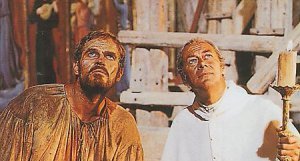 Julius: You know Buoneratti, I almost let you off. Twice. When I felt sorry for you. Are you glad now that I did not?
Julius: You know Buoneratti, I almost let you off. Twice. When I felt sorry for you. Are you glad now that I did not?
Michaelangelo: I’m grateful.
Julius: Save your gratitude for one who deserves it. No, not I. I was ruled by another hand. As easily and skillfully as you move your brush. Strange how He works His will. Let us share pride in having been His instruments.
Michaelangelo: It’s only painted plaster, holy father.
Julius: No, my son it’s much more than that. What has it taught you, Michaelangelo?
Michaelangelo: That I am not alone.
Julius: And it has taught me that the world is not alone.
Best Scene:
It’s really two scenes that refer directly to the other.
After two years of lying on a high scaffold inhaling paint fumes, Michaelangelo’s body at last gives out on him and he collapes, nearly falling to his death and becoming bedridden. After a few months, during which Michaelangelo has been nursed in his papal apartment by the Contessina de Medici, Julius pays a visit and tells him not to worry any more about the ceiling. He intends to transfer Michaelangelo’s commission to Raphael, whom it is implied Michaelangelo has a bit of a distaste for. This motivates the previously coughing, weak Michaelangelo to spring from his bed and head straight back to work.
Later in the movie, Julius collapses at some point in the midst of his military campaigns. It’s the darkest hour, when all of Rome’s enemies are marching into Italy. Confined to bed just as Michaelangelo was, it really appears he will not rise again. He lies in state, eyes closed, with all the papal attendants lurking in the incense heavy room. Behind a curtain a priest directs a choir of sopranos in a mournful angelic dirge, apparently easing Julius’ soul to heaven. Michaelangelo enters and goes to the pope’s bedside. They talk quietly back and forth about the situation in Rome and Michaelangelo kisses Julius’ hand and says he has come to say goodbye. He is taking his leave and returning to Florence, reasoning it is useless to continue painting with the enemy about to descend on Rome.
“Wait,” rasps Julius, as Michaelangelo gets up to leave. “You- you dare leave your work without my permission?”
“Then I ask permission of your holiness.”
“It is refused!” he hisses, his voice gaining ire. “Do you hear? You will complete your work!”
“Why should I?” Michaelangelo asks calmly, shrugging. “You haven’t completed yours, holy father.”
“Insolence!” Julius snarls, sitting up in his deathbed.
“Why don’t you take a stick to me?” Michaelangelo chides. “You did before.”
Julius throws off his covers and swings his legs out of bed, glaring at the artist.
“You will return to the Sistine Chapel or you will go to a dungeon, my son.
“Yes holy father,” Michaelangelo smirks. He turns and leaves without a look back.
Julius looks around at the fawning priests, doctors, and cardinals, all of them wide-eyed at his apparent recovery.
He glares at the priest conducting the choir. The conductor hastily waves for the boys to stop singing and then throws them into a hilariously joyful rendition of ‘Hallelujah’ as Julius gets to his feet and yells;
“What are you all doing here? Don’t you have other duties? Do you think I intended to die? Out, jackals!”

Michaelangelo is inspired.
Would I buy it again? Yes.
Next In The Queue: Alien








May 16, 2012
Some Words And An Excerpt From Gully Gods
FOUR IN THE MORNING is fast approaching.
It’s an eclectic collection of four entirely different dark novellas, the brainchild of contributor Lincoln Crisler (editor of CORRUPTS ABSOLUTELY?) and also featuring stories by myself, Malon Edwards, and Tim Marquitz.
When Lincoln approached me with the idea for this collection, he suggested we loosely use the theme of ‘age’ as a jumping off point, as in one of us do youth, another middle age, and another the golden years. When Malon came on, he and I decided to split youth into adolescence and young adulthood.
The novella I wrote for this project is called GULLY GODS.

Pilsen
GULLY GODS started way back in 1997 with an entirely different cast of characters but a similar setting, the Lower West Side of Chicago, around the historic Pilsen neighborhood, traditionally a kind of port of entry neighborhood for foreign immigrants to the city, beginning with Czechs in the early nineteenth century and gradually becoming predominately Mexican in the twentieth.I wanted to explore late 90′s street gang culture, sort of in the way Harlan Ellison did back in the 50′s (but without actually joining a gang, obviously), and it occured to me (as almost everything I study does) to infuse it with weird fiction. Actually, the first time I heard the term ‘Urban Horror’ or ‘Urban Fantasy,’ I ran it through my outdated 90′s PC filter, when every thing ‘urban’ meant ‘hip-hop’ related. So I set out to write this thinking I was writing Urban Horror because the whole time I had an old school hip hop soundtrack going in my mind (and I never ever write to music. But more on that in another post). Then while walking past a booth at San Diego Comic Con last year I came across an Urban Horror publisher and saw the covers were almost entirely populated by white women in black leather pants, emulating the chick from Underworld (who to me, was already a second generation Trinity from The Matrix). Open up another window and do a google search for Urban Fantasy and you’ll see what I mean. A slew of skinny chicks in black t-shirts.
But I digress.
As things sometimes do, the most vivid scene I had written wound up showing up almost to the T in a major motion picture release (the curb job in American History X), so I sort of became disenchanted with the material and the story never really took off in my mind. It sat dormant way back there for a lot of years, but Lincoln brought it back out itching.
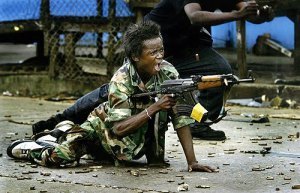 I decided to revisit the concept (a group of hardcore gangbangers who pay homage to a dark and very real deity which grants them supernatural powers) from the point of view of Africans/African Americans instead of Puerto Ricans, as was my initial idea.
I decided to revisit the concept (a group of hardcore gangbangers who pay homage to a dark and very real deity which grants them supernatural powers) from the point of view of Africans/African Americans instead of Puerto Ricans, as was my initial idea.
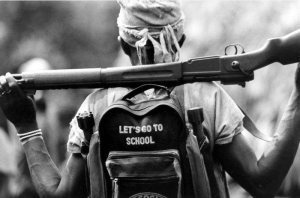 I think what made it click was my recent research into the child soldiers of Liberia, an absolutely deplorable phenomenon that’s been practiced there and in several other countries for as long as men have aimed guns at one another. My interest in Liberian child soldiers started after I’d streamed the Vice Guide To Travel’s harrowing episode on Liberia, and become acquainted with Joshua Blahyi, AKA General Butt Naked.
I think what made it click was my recent research into the child soldiers of Liberia, an absolutely deplorable phenomenon that’s been practiced there and in several other countries for as long as men have aimed guns at one another. My interest in Liberian child soldiers started after I’d streamed the Vice Guide To Travel’s harrowing episode on Liberia, and become acquainted with Joshua Blahyi, AKA General Butt Naked.
Blahyi is a reformed warlord turned Christian minister in Liberia. During the country’s bloody civil war, he devoted himself to a personal deity which required the blood of murdered children as sacrifice and in turn supposedly granted him immunity from bullets if he strode into combat stark naked (which he did). The majority of his Butt Naked Brigade consisted of armed children, sometimes as young a nine years old, kidnapped from their home villages, beaten, often sexually abused, and strung out on drugs, usually ‘brown brown,’ a mixture of cocaine and gunpowder, which left them in a perpetual state of heightened paranoia and agitation. 
Their former identities as sons and brothers were completely wiped away. They traded their real names for ‘battle names’ like Walking-Fucking, Rambo, Khadaffi, and Captain War Boss. They were trained to show no mercy to their enemies, and encouraged to brutalize and rape civilians at their pleasure (we’re talking rape from the time they’re first able to even attempt sex). Following Blahyi’s vision, the boys strutted into combat either nude, or wearing evening gowns, outrageously colored wigs, and handbags, which they believed confused enemy bullets.
I read Uzodinma Iweala’s child soldier novel BEASTS OF NO NATION and several positively chilling first hand accounts from ex-(child) combatants and their victims, a few of which wound up as recollections of the characters in GULLY GODS.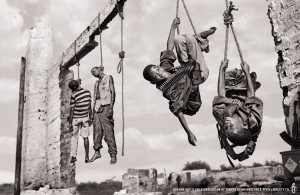

Joshua Milton Blahyi AKA General Butt Naked
GULLY GODS’ ‘hero’ if it has one, is an African American Houston teenager named J-Hoss, who, having been caught up in the South Houston gang culture, witnesses and promptly avenges the death of his best friend at the hands of Mexican rivals, and goes to Chicago to lay low with his aunt and young cousin.Like Father Flanagan, I’m not of the opinion that there are natural born ’bad boys.’ There are kids who have gone bad, sure, and J-Hoss is one of them. At an early age his father was incarcerated, and he was fortunate enough to have been partly raised by his grandfather, a hardworking ex-cowboy who instilled him a sense of personal history and a moral code.J’s family comes from the Mascogo. The Mascogo are African-Mexicans, descended from the Black Seminoles of Florida. The Black Seminoles came about when Africans fled to Spanish territory and mingled with the Seminole Indian tribes there, becoming part of their community. After fighting the United States nearly to a standstill in the everglades during the Seminole Wars, the Black Seminoles were faced with the prospect of slavery and removal to Oklahoma (Indian Territory). A group of them chose instead to head for Mexico, where they established the town of Nacimento with the full blessing of the Mexican government, who prized them as scouts and trusted them to defend the northern borders against American bandits and hostile Apaches (how the world turns, right?).
The leader of this group was called John Horse, and it’s from John Horse that J-Hoss takes his name.
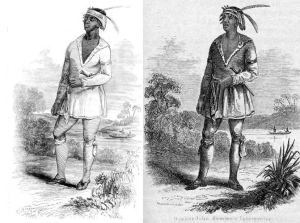
Juan Caballo, or John Horse
After his grandfather’s death in a nursing home, J-Hoss finds himself not always living up to the code he was taught, acting selfishly as teenaged boys do, but in the volatile and hostile world of the gangster, which soon makes him a dangerous individual.Expecting a peaceful sojourn in Chicago, J-Hoss strikes up a relationship with a Mexican girl from the new neighborhood, which soon draws the ire of the local Mexican gang. Pretty soon it’s more of the same, except here, J-Hoss doesn’t have his own gang to back him up, and in addition he’s made a promise to his aunt and her Muslim boyfriend not to endanger their home or the life of his young cousin with any of his criminal dabblings.
But when a small but ambitious and up and coming Liberian immigrant gang called the Trip Sixes sides with him against the Mexicans and extends a friendly hand to him, it’s understandably difficult for J-Hoss to say no.
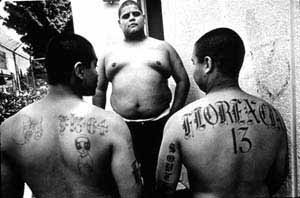 Soon events transpire to send him headlong back into the life he’s forsworn. But the Trip Sixes (led by an intense ex-child soldier who calls himself Hitler) are nothing like any gang J-Hoss has ever known.
Soon events transpire to send him headlong back into the life he’s forsworn. But the Trip Sixes (led by an intense ex-child soldier who calls himself Hitler) are nothing like any gang J-Hoss has ever known.
They court a terrible, dangerous power, an old power that hungers for bloodshed.
Here’s the first two pages….
All the bad started when the Southside Cholo’s rolled up on me and Bruce Wayne in the Subway parking lot on Aldine Bender Road in Houston.
I’d been bangin’ with the five deuce Hoovers since fifth grade, mostly slangin’ weed and rock to the hypes at Haverstock Hills where I’d stayed in an apartment with my moms since my granddaddy died when I was ten.
It was all over a damn dog.
Bruce Wayne had this white pit bull named Cripto. He’d had a special collar made to order, with little pockets on the inside to keep the rock in. He said he got the idea from a Punisher comic. That was a mean ass dog and it wouldn’t let nobody touch it but him. I used to tell him I thought one of the pockets had ripped and Cripto had got a nose full of shit, because that damn dog acted like a crackhead.
Bruce Wayne loved that dog though, and he would tell me to shut the fuck up about it.
Now you know Bruce Wayne wasn’t that nigga’s real name. It was really Bruce Wayne Charles. Nigga was crazy about comic books. He went by Bruce Wayne, or B-Wayne, or Mista Wayne. Nigga changed his name more times than Diddy. I just called him B like I always had when we was kids.
After me and him got jumped into the Hoovers and he started makin’ his papes, B got hisself a big gold chain thick as a baby’s wrist with this fat ass bat signal hung on it. The bat was all in diamonds and the yellow part was gold. It was sick. Like I said, nigga was crazy about comic books.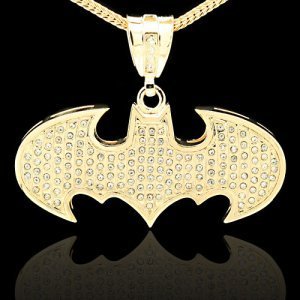
He used to say me and him was gonna O.G. a clique one day, and all the gangstas was gonna have superhero names. Five Deuce SupaFiends, he wanted to call it. Nigga wanted me to call myself Black Bolt or some gay shit. My nickname J-Hoss though, after John Horse, this Black Seminole my granddaddy used to tell me stories about.
And anyways, I like the X-Men.
It was a real hot night. We was chillin’ in the Subway parking lot smokin’ beedies and eatin’ footlongs over the trunk of his ride (a tricked out two toned black and grey’92 Buick Roadmaster nigga called The Batmobile – had chrome bats on the dub spinners) and listenin’ to ‘Face when a pickup full of Southside Cholos pulled up and got out.
 They didn’t pay no attention to us and I told B to keep chill, ‘cause I knew even though he was strapped I’d left my deuce deuce at home and I didn’t want no ‘plex.
They didn’t pay no attention to us and I told B to keep chill, ‘cause I knew even though he was strapped I’d left my deuce deuce at home and I didn’t want no ‘plex.
I hadn’t never been no killa then. Sure, I busted caps in a couple fools, beat some slobs down, but I ain’t never heard nothin’ ‘bout none of ‘em dyin.’
Anyways they was five of ‘em, all bald-headed in they khaki shorts with they socks pulled up and they little mustaches and wife beaters, lookin’ all the same like soldiers. They had this trick with ‘em, hair all wet lookin’ and lotsa lipstick like they like ‘em. She had a dog in her arms, if you could call it a dog. It was one of them yappy little Mexican mutts like in the Taco Bell ads. Ain’t no fuckin’ dog. This one was black. Never seen a black one before. Looked more like a big ant than a little dog.
Cripto got a whiff of that motherfucker and stood up, and I guess that little dog smelt him too, ‘cause next thing we knew it had jumped out that bitch’s arms and was bouncin’ around in a circle barkin’ its goddamn head off.
Now I thought B had Cripto hooked to something, but that fool had just put his foot on the chain while he ate, and that motherfucker got loose and run across the parking lot, the chain just dancin’ and janglin’ behind.
It run right up to that little yappin’ mutt, right in the middle of them SSC’s. It picked that little bitch up in its teeth and bit down, gave it a shake. Thing stopped yappin’ right there. I think I heard the neck snap clean across the parking lot.
Then Cripto, big dumbass that he was, come trottin’ back to me and B with the thing hangin’ out his mouth, like he was bringin’ us a rabbit or something.
“Oh shit, ” B says, ‘cause all them Cholos come marchin’ in behind the dog, and the dog come right at us, and the bitch was cryin’ and screamin’ about her perrito.
“’Ay! ‘Ay!” one of the Cholos yelled, and they all started yellin’ at once, callin’ us motherfuckers. This big one run up and put his foot down on Cripto’s chain, pullin’ him up short. He dropped the dead dog on the ground and the bitch started yellin’ in Spanish for them to kill ‘these two niggers and their fuckin’ dog.’
The big one picked up Cripto’s chain and pulled him up to his shoulder, so Cripto was on his back legs, chokin’ and snappin’ and fightin’ to get away.
“This your dog, homie?”
“Yeah ma’fucka and you better let him go,” said B.
I didn’t like that dumb fuckin’ dog, but I hated to see him gaggin’ that way, twistin’ on the chain.
“The fuck you say, puto?”
“You heard him ma’fucka,” I say.
“What set you with, puto? You a ma’fuckin’ crab?”
Me and B looked at each other, and B pulled up his shirt, showin’ his orange belt.
It drove ‘em crazy. They was like dogs theyselves, and they started into thowin’ up they set, twistin’ they fingers up and frontin’ hard, talkin’ ‘bout they Hoover Killa Criminals and they goin’ fuck us up.
B backed up a bit, and that drove ‘em crazier, ‘cause they figured they had us faded. They stepped to us, and the big motherfucker pulled Cripto off his feet, but B bumped against me like he meant to, and I took his Glock out the small of his back and pulled it, unlocked and cocked.
I only wanted to scare them slobs off…
Gully Gods is coming soon in Four In The Morning.
There are several international charitable organizations which work toward preventing and raising the awareness of the forced ‘enlistment’ of children in combat and rehabilitating former child soldiers. Among them are:
http://childsoldiersinitiative.org
The United States has its own child soldier dilemma, and it doesn’t gain much sympathy from the public. There are a few organizations out there that work with lower income communities and troubled youth in danger of becoming victims of the pervading gang culture. An internet search will turn up any number in your own area. All of them are in dire need of support.
(LA-based organization that exclusively trains and employs ex-gang members and at-risk youth. ‘Nothing stops a bullet like a job.’ Homeboy is currently on the rocks and could definitely use some help.)
http://www.catholiccharitiesusa.org
http://www.resurrectionproject.org
(works to improve the historic Pilsen neighborhood of Chicago with affordable housing, childcare, and community outreach programs)








May 9, 2012
Bigfoot Walsh In Welcome To Hell: An Anthology Of Western Weirdness
Coming at you from E-Volve Books is WELCOME TO HELL: AN ANTHOLOGY OF WESTERN WEIRDNESS, edited by the maestro of all things Sasquatch, Eric S. Brown.
First take a look at this cover. I think it’s one of the best my work’s ever appeared under to date.
Reminds me a still from the opening credits of a Leone movie.
I’m told the title of the anthology is a direct reference to the words the stranger paints over the Lago town sign in HIGH PLAINS DRIFTER, a movie I’m a tremendous fan of.
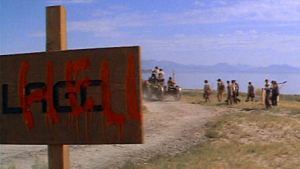 I’m in great company here – Stoker Award Winner Joe McKinney, fellow Dark Moon Books alum Max Booth III, Aaron J. French, Franklin E. Wales, Suzanne Robb and more.
I’m in great company here – Stoker Award Winner Joe McKinney, fellow Dark Moon Books alum Max Booth III, Aaron J. French, Franklin E. Wales, Suzanne Robb and more.
My own offering, BIGFOOT WALSH, takes place inFredericksburg,Texas around 1849. A troop of Texas Rangers rides into town seeking one German doctor Wilhelm Keidel, to accompany them. They have received reports of Comanche Indian depredations in the hill country, and want to bring a doctor along as they investigate the remote settlements in case of wounded survivors.
Discovering a burned out cabin with its goods and weaponry largely untouched but its horses brutally butchered and womenfolk stolen, the Rangers are also joined by legendary Texas Ranger Lieutenant ‘Bigfoot’ Walsh (no relation to real-life ‘Bigfoot’ Wallace, though they are acquainted), a tremendously large and hairy individual who is said to be of Lithuanian extraction. He rides no horse, goes barefoot upon a pair of huge feet, and sports a Brand Rifle loaded with a broomstick lance, a weapon usually reserved for killing whales.

Brand Rifle
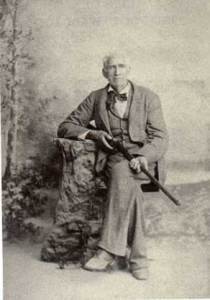
Bigfoot Wallace
He also dismisses the Rangers’ assertion that they are tracking Comanche Indians, pointing to a set of overlarge tracks in the mud. Their quarry is something altogether more dangerous, something Walsh himself has a certain connection to….
Fredericksburg is a real community, called Fritz Town by the old-timers, as it was established soon after the Mexican War by German immigrants, and named for Frederick of Prussia.
Fredericksburg was interesting and perhaps totally unique in their dealings with the local Penateka Comanche tribe, in that they settled for peace early on, and enjoyed a lasting armistice the surrounding Texans did not.
One cool tradition dating back to the signing of the treaty which purportedly continues inFredericksburgtoday is the lighting of bonfires on the surrounding hilltops during Easter Eve.
During the negotiations, the Comanche camped on hilltops all around Fredericksburg, and their fires could be seen at night. To alleviate the fears of their children, the German mothers told them the fires were the Easter Bunny boiling eggs to be painted for the morning’s hunt.
Dr. Wilhelm Keidel, who appears in my story, really was the first licensed doctor practicing in Gillespie County. A veteran of the Mexican War himself (in the First Texas Foot Rifles), he also became the county’s first Chief Justice, and founded the nearby town of Pedernales. He never refused treatment based on creed, race, or loyalty, even during the War Between The States, and was called ‘Butcher Knife’ by the Comanche whom he often treated (maybe something is lost in the translation).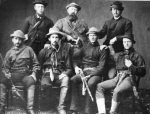
Chief Santa Ana (who is mentioned in BIGFOOT WALSH) of the Penateka Comanche was a modestly renowned war chief, having participated in the Council House Fight and the Great Raid Of 1840, in which the Comanches burned out two anglo cities and conducted bloody raids all the way to the Gulf of Mexico. Nevertheless, he was one of the instrumental parties of the Penateka band in the signing of the Meusabach-Comanche treaty inFredericksburg.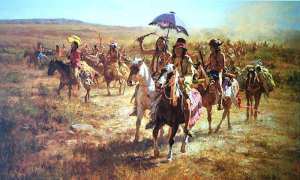
In 1849 the Penateka Band dissolved, reportedly due to a severe outbreak of cholera (which Dr. Keidel and the Germans of Fredericksburg were also dealing with at that time). Chief Santa Ana was one of the victims, though his son Carne Muerto (Dead Meat) survived and joined the Kwahadi Band of Quanah Parker.
My story says different, of course…

Not afraid? You will be….you will be.
The climactic scene of the story takes place on Enchanted Rock. AKA Spirit Song Rock, it’s a huge pink granite monadnock where the renowned Texas Ranger Captain John C. Hays supposedly singlehandedly held the high ground against a superior force of Comanches in 1841.
Legends about the area say that Comanche and Tonkawa bands held sacrifices on its summit in prehistoric days, and that it was a portal to other worlds. There is also a story of a Spanish priest who fell into a hole in the rock and was lost in underground tunnels for days, where he encountered hordes of mystical beings before finding his way out again.

Enchanted Rock (or Spirit Song Rock)
Just a few of the real life ingredients that went into BIGFOOT WALSH.Now go pick up the anthology and sip the brew I came up with.
I’m told the print edition is forthcoming.
Hasta pronto,
Ed











